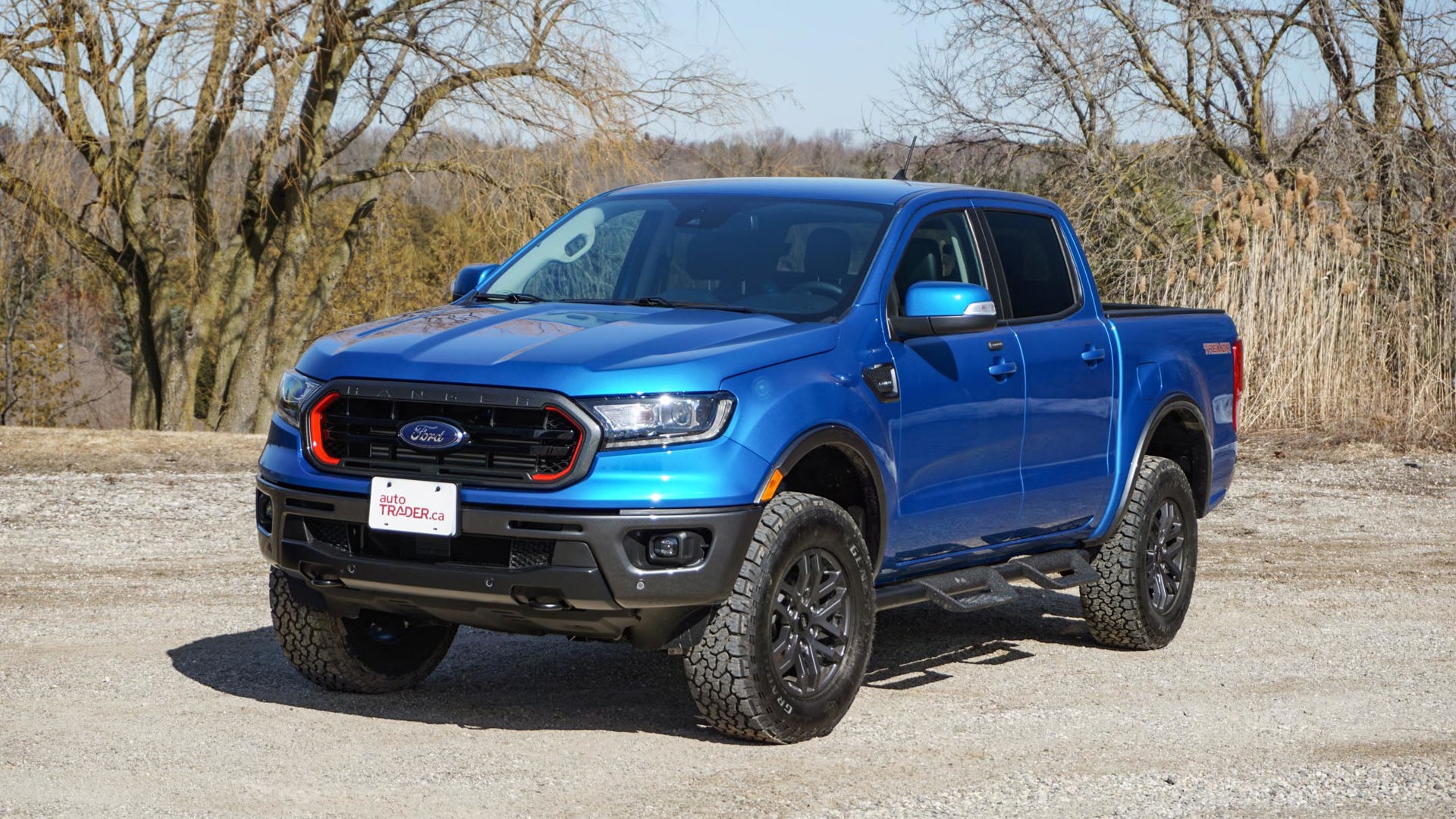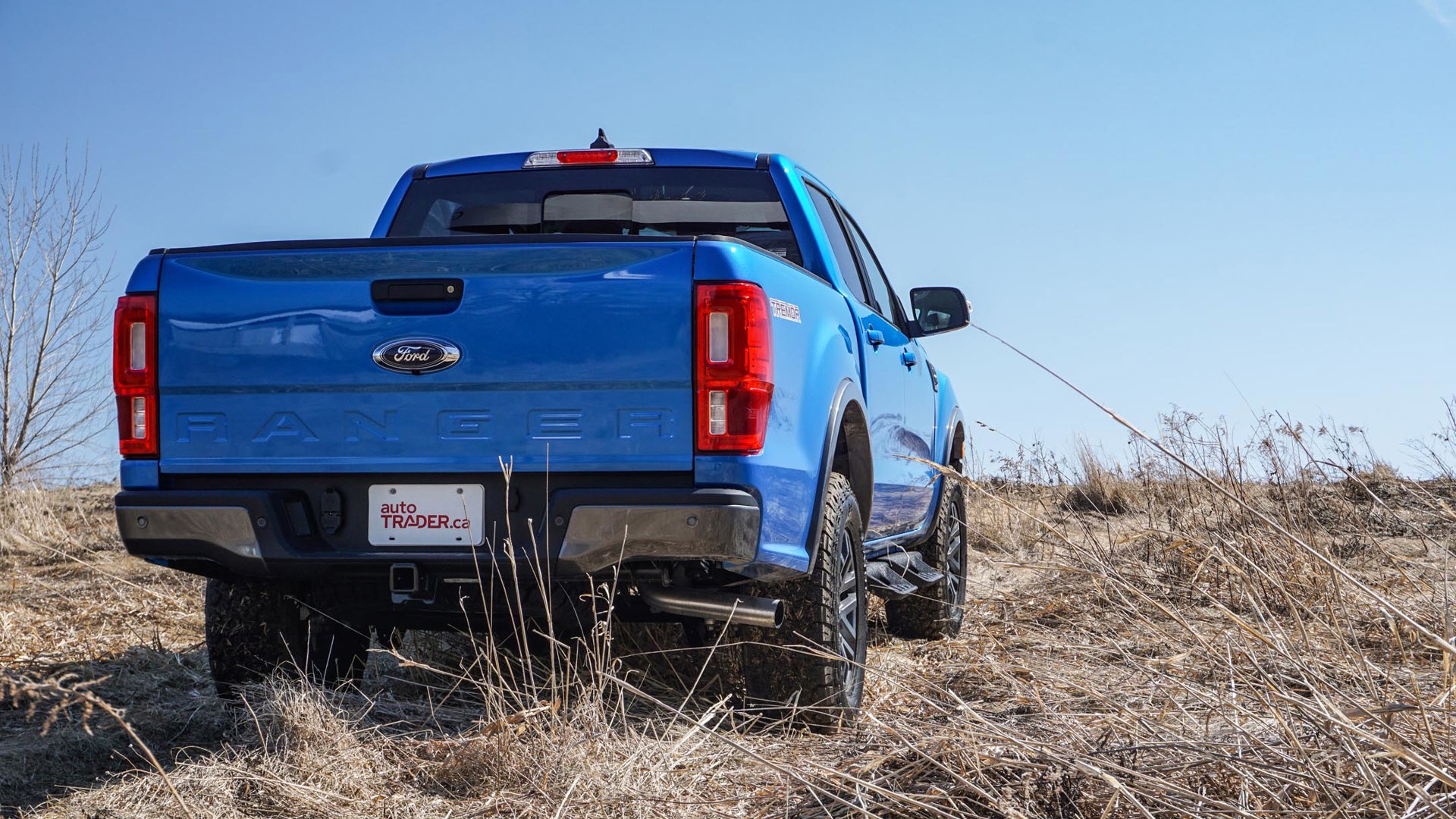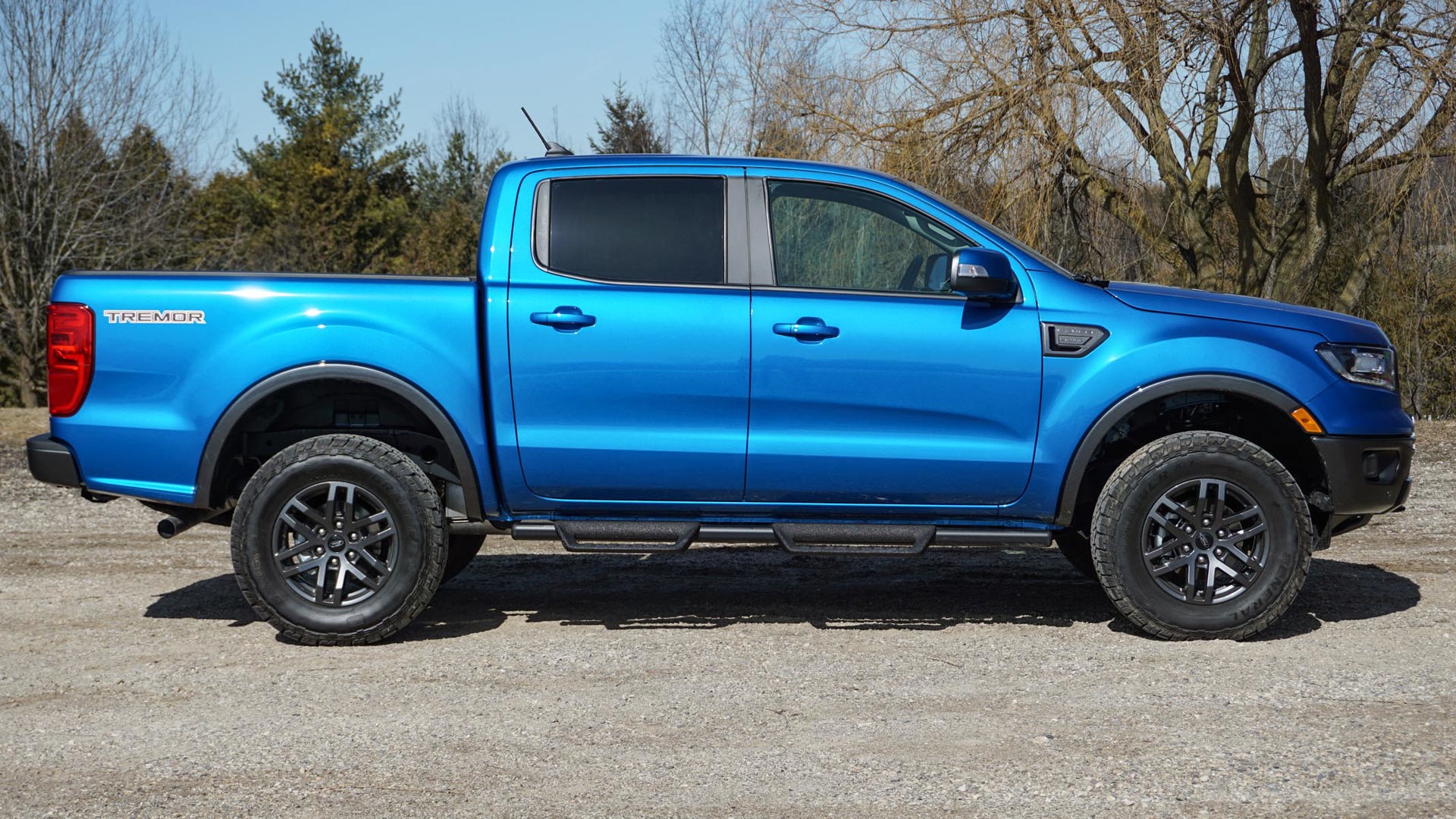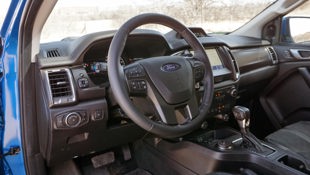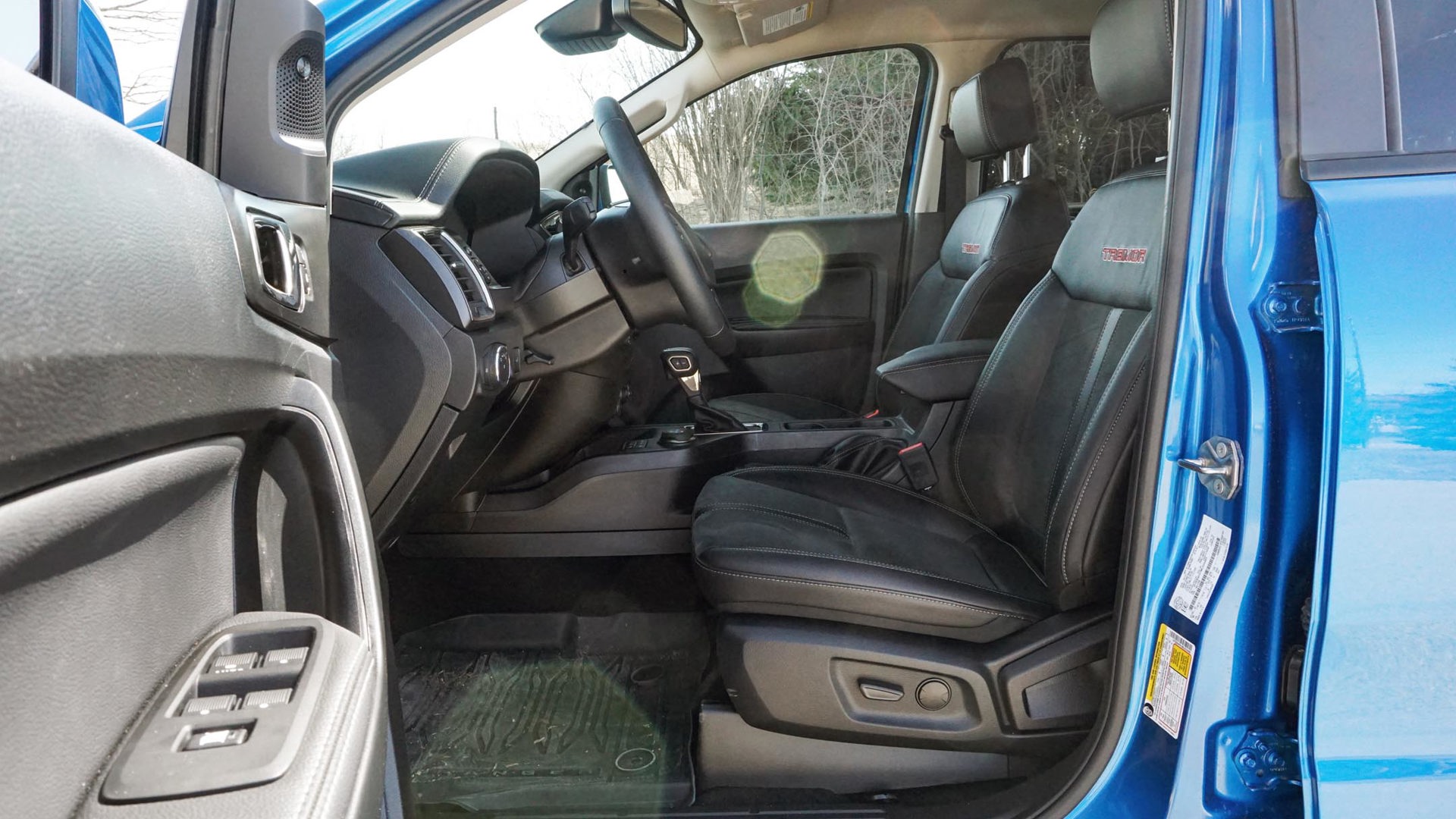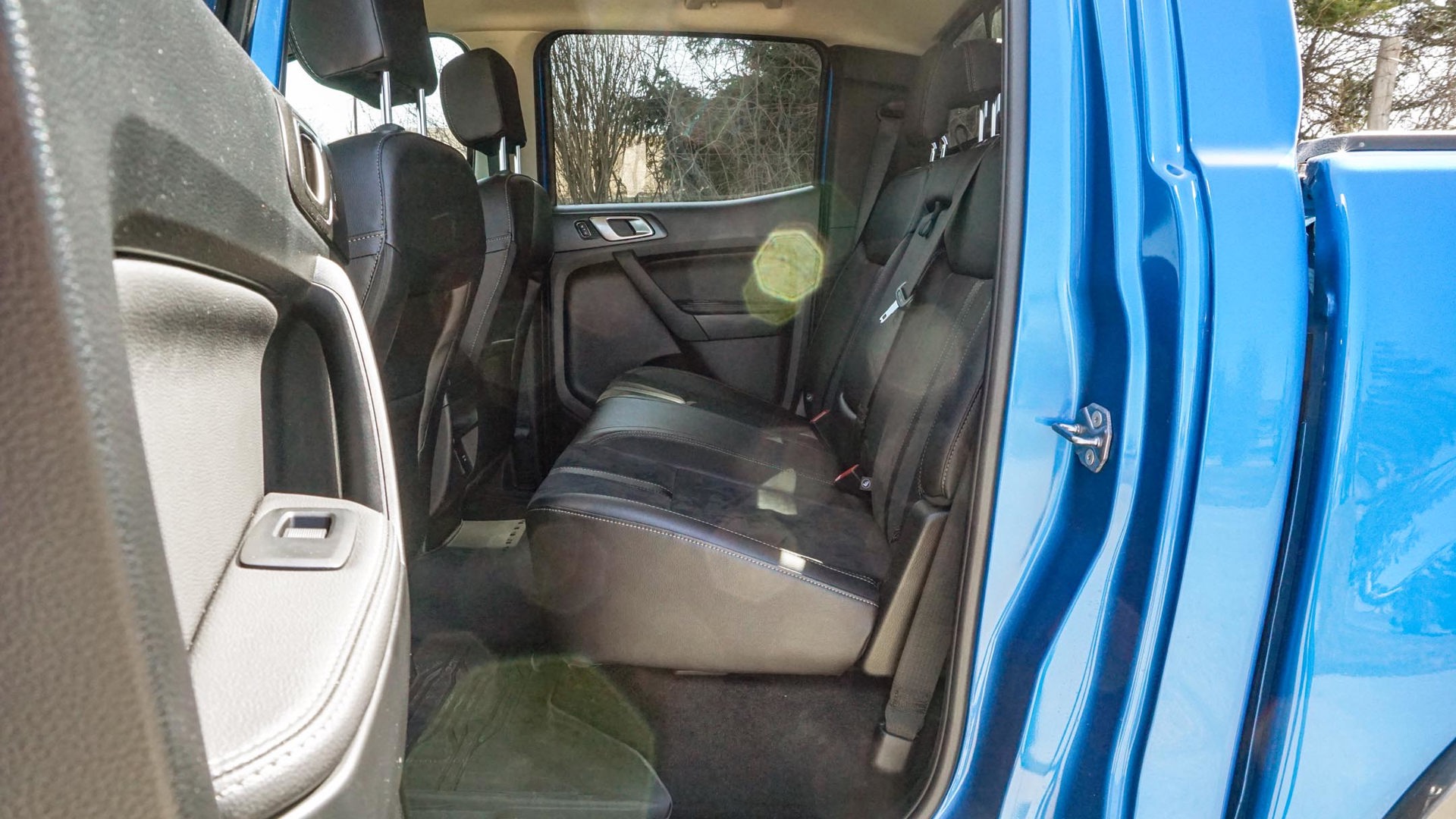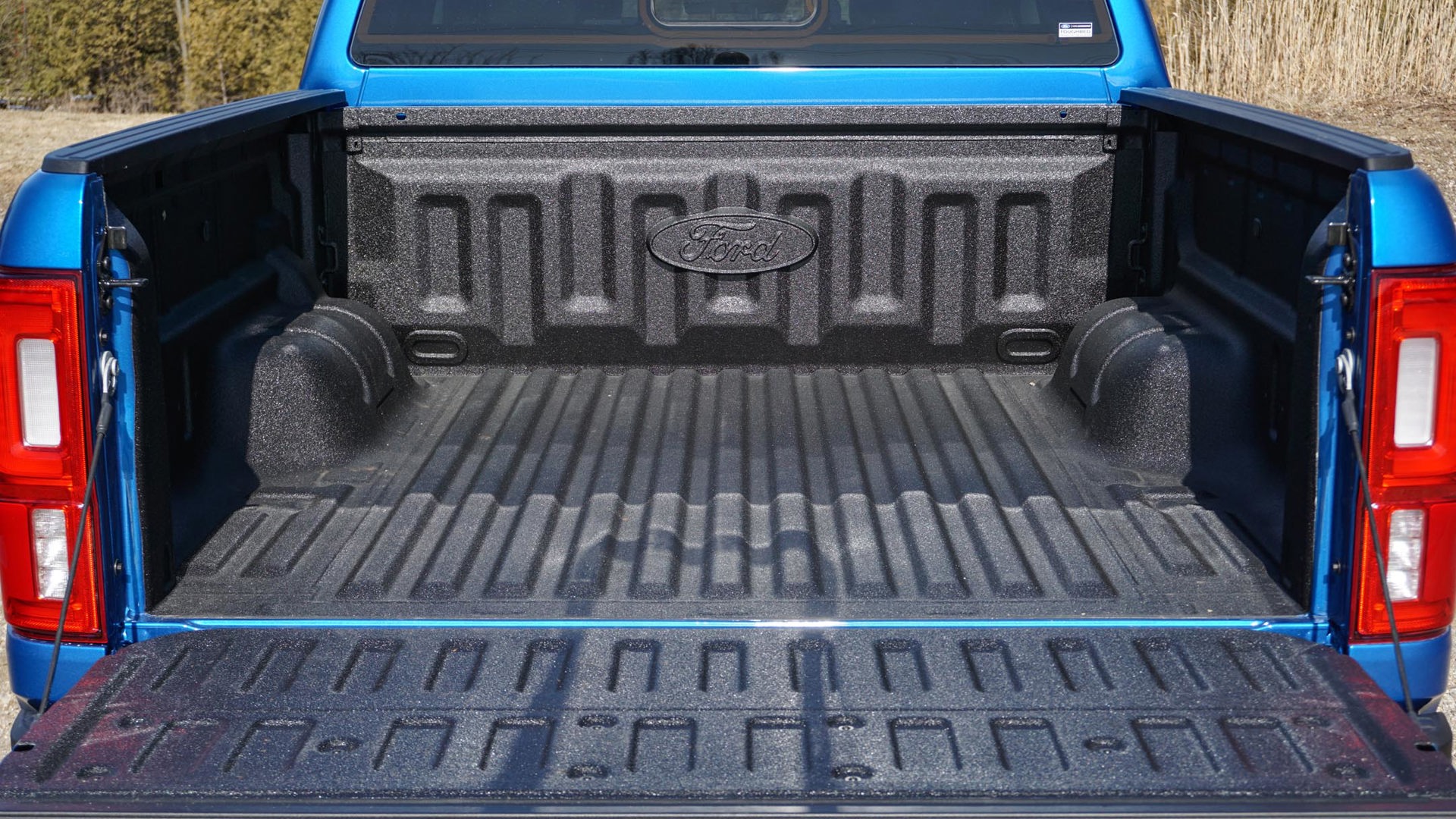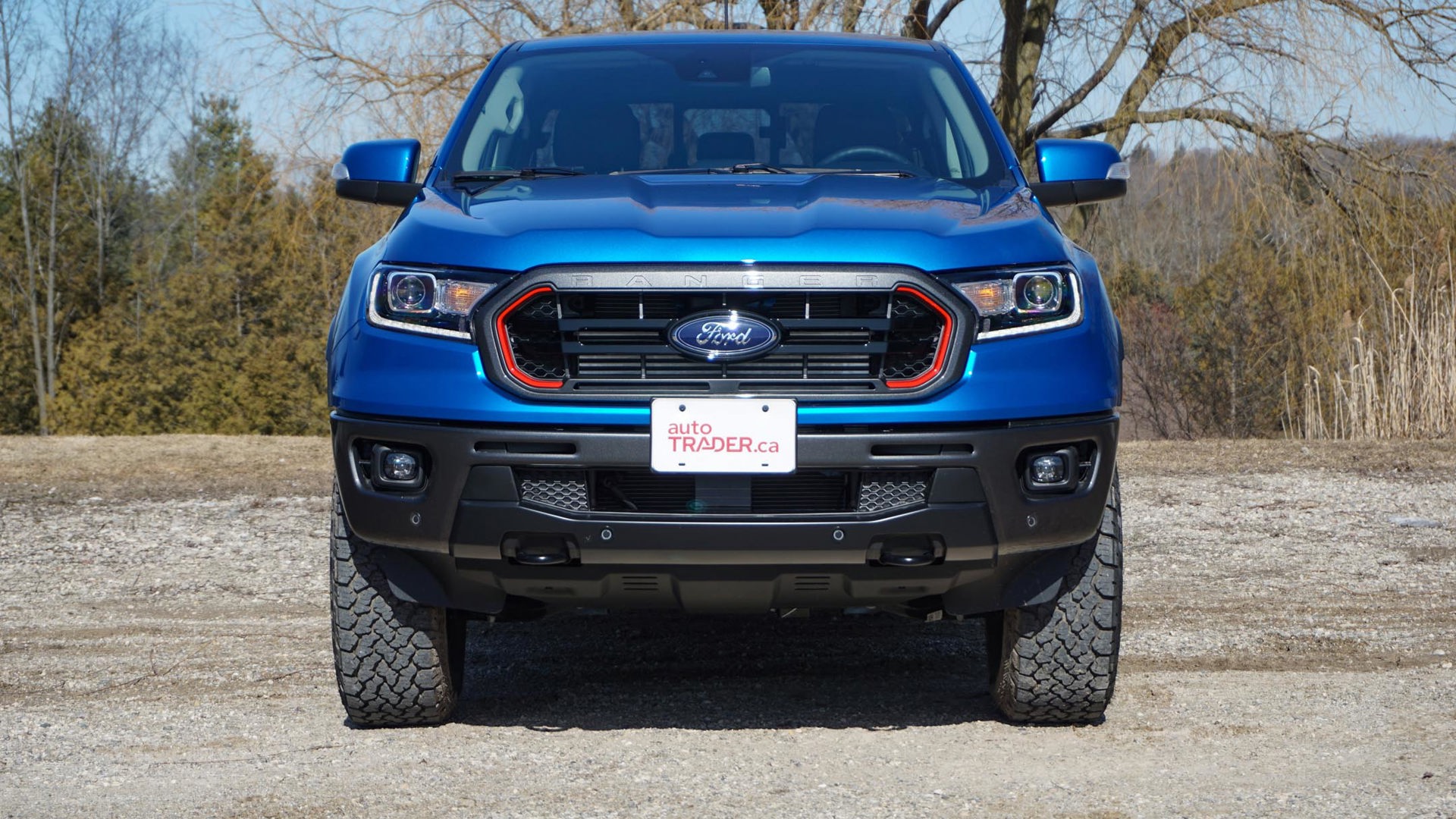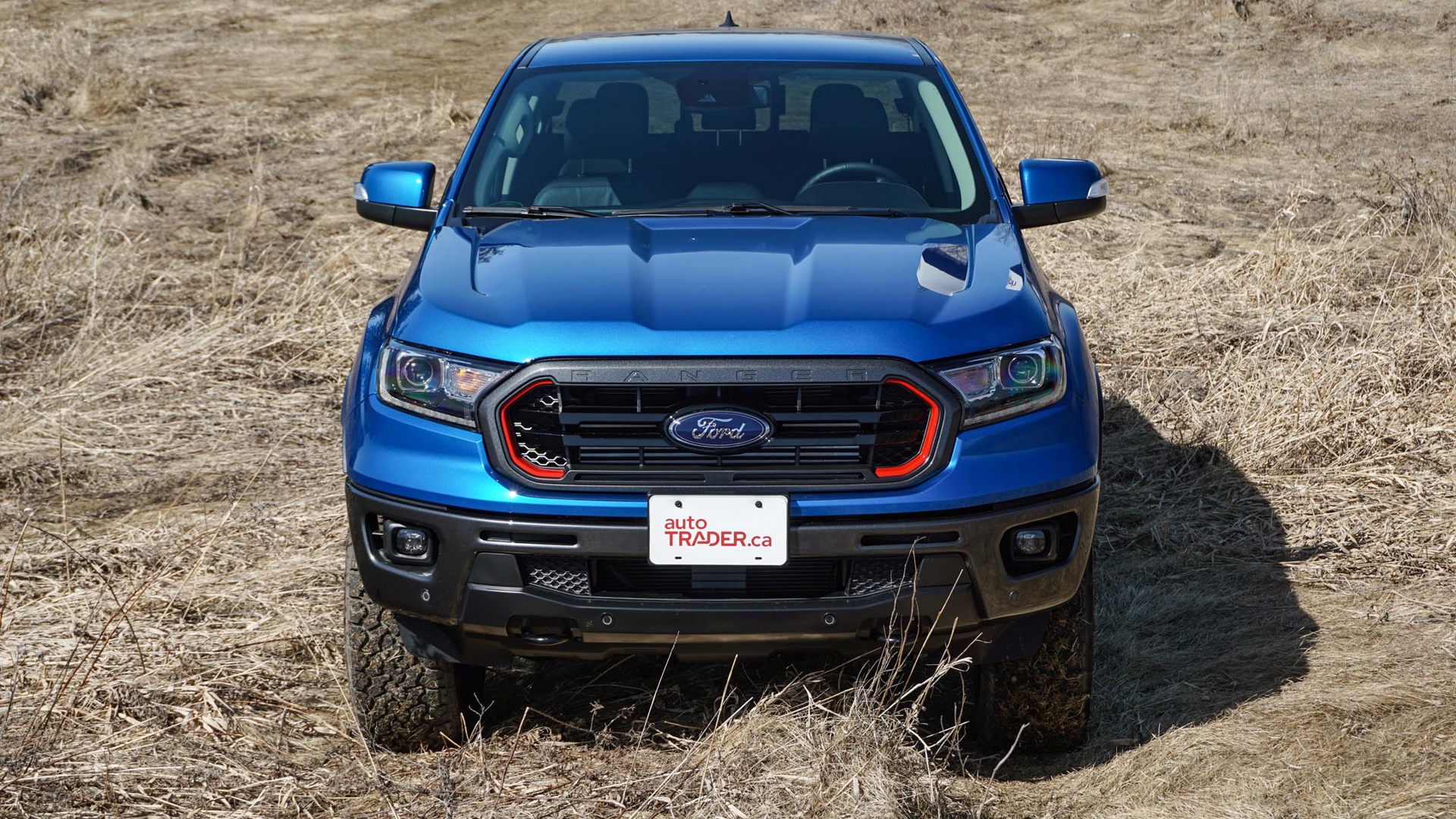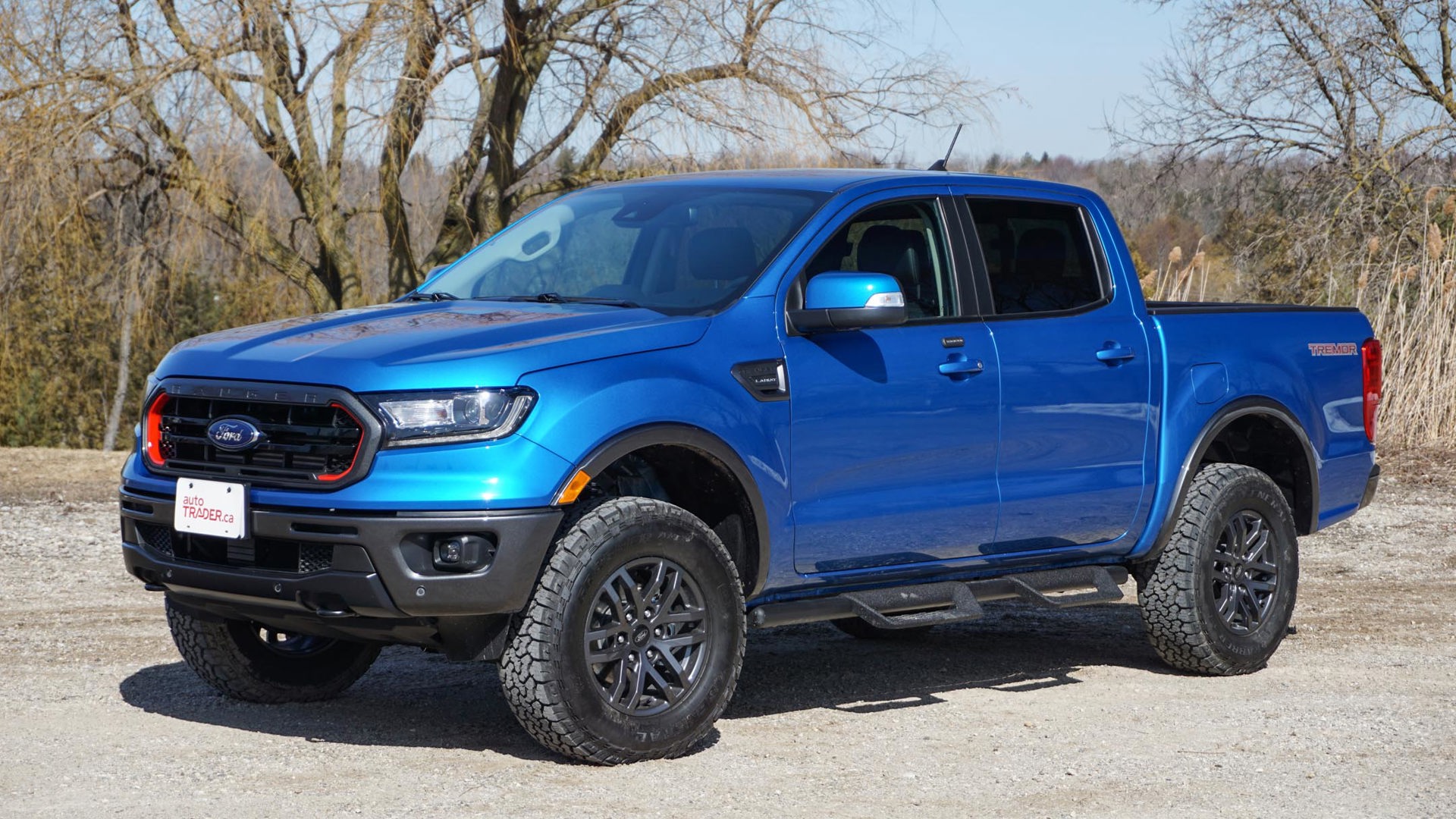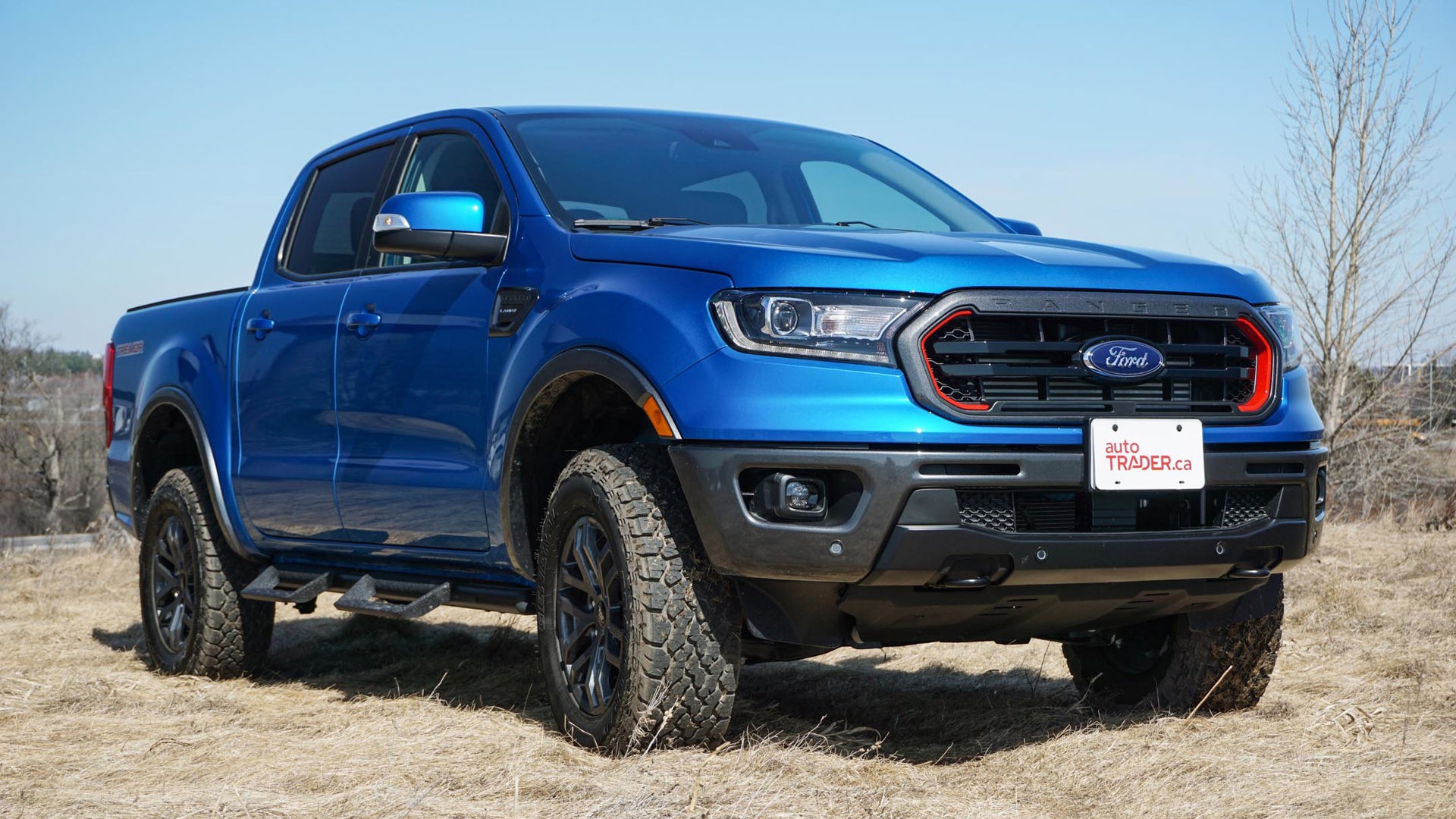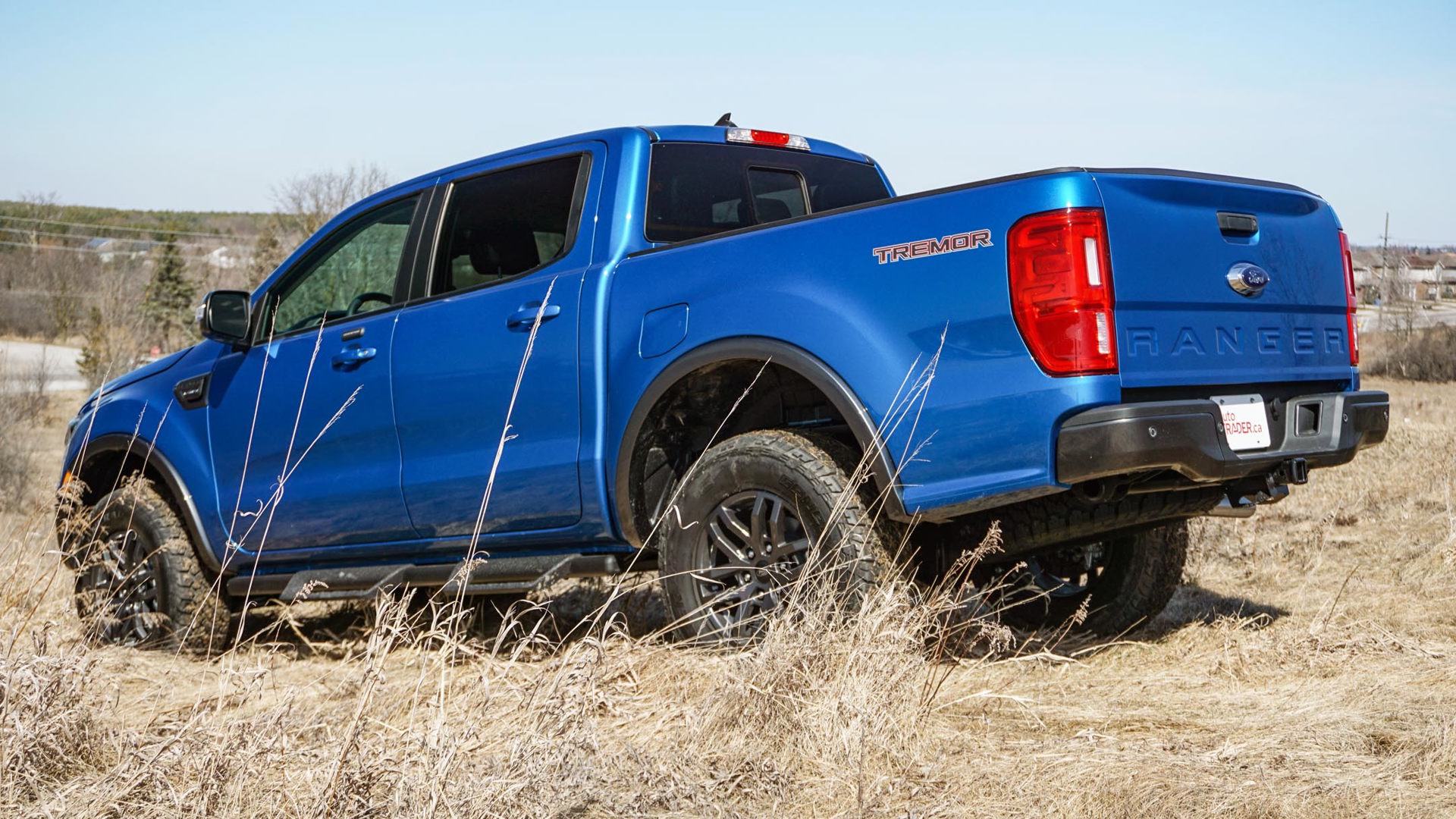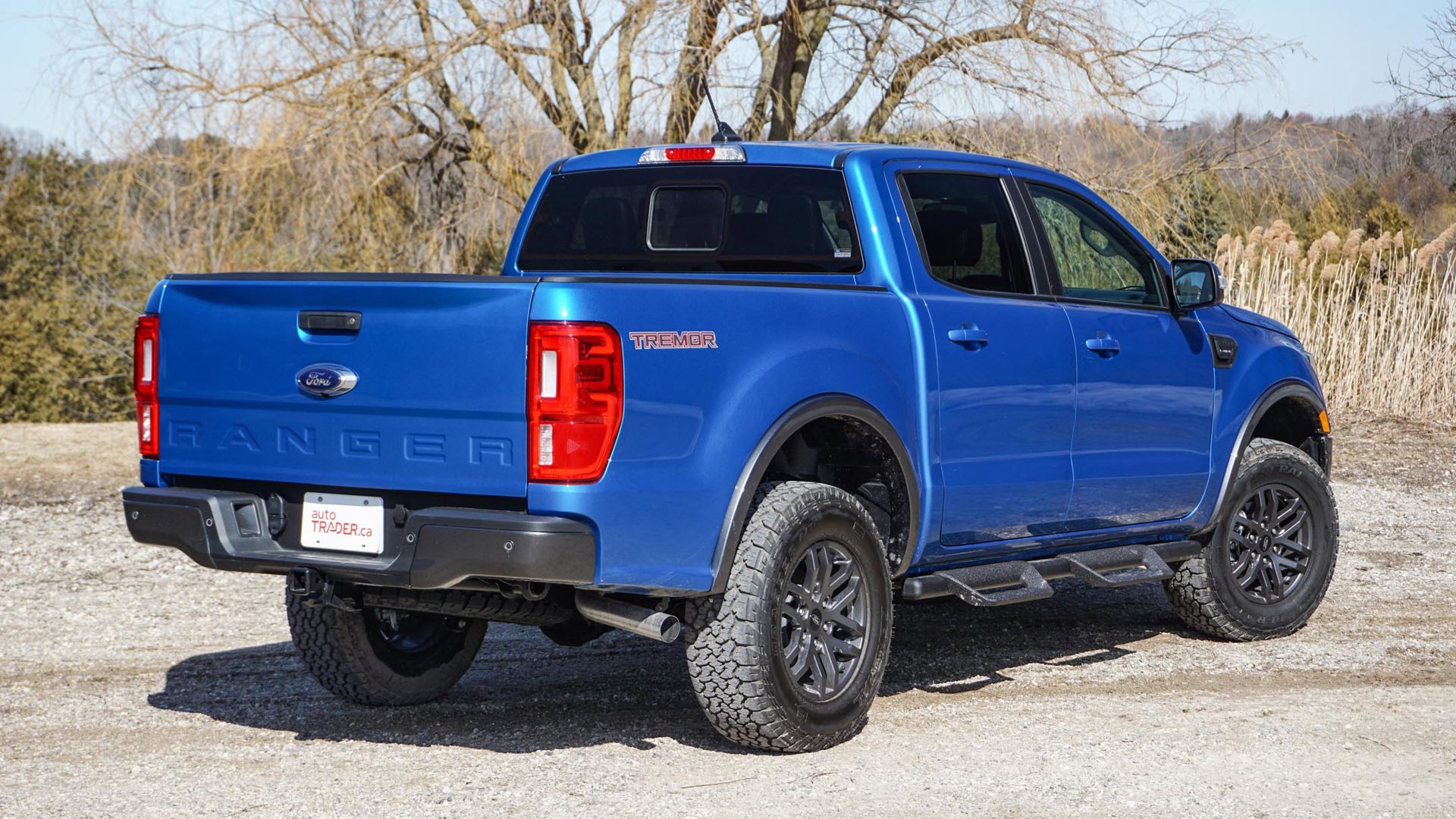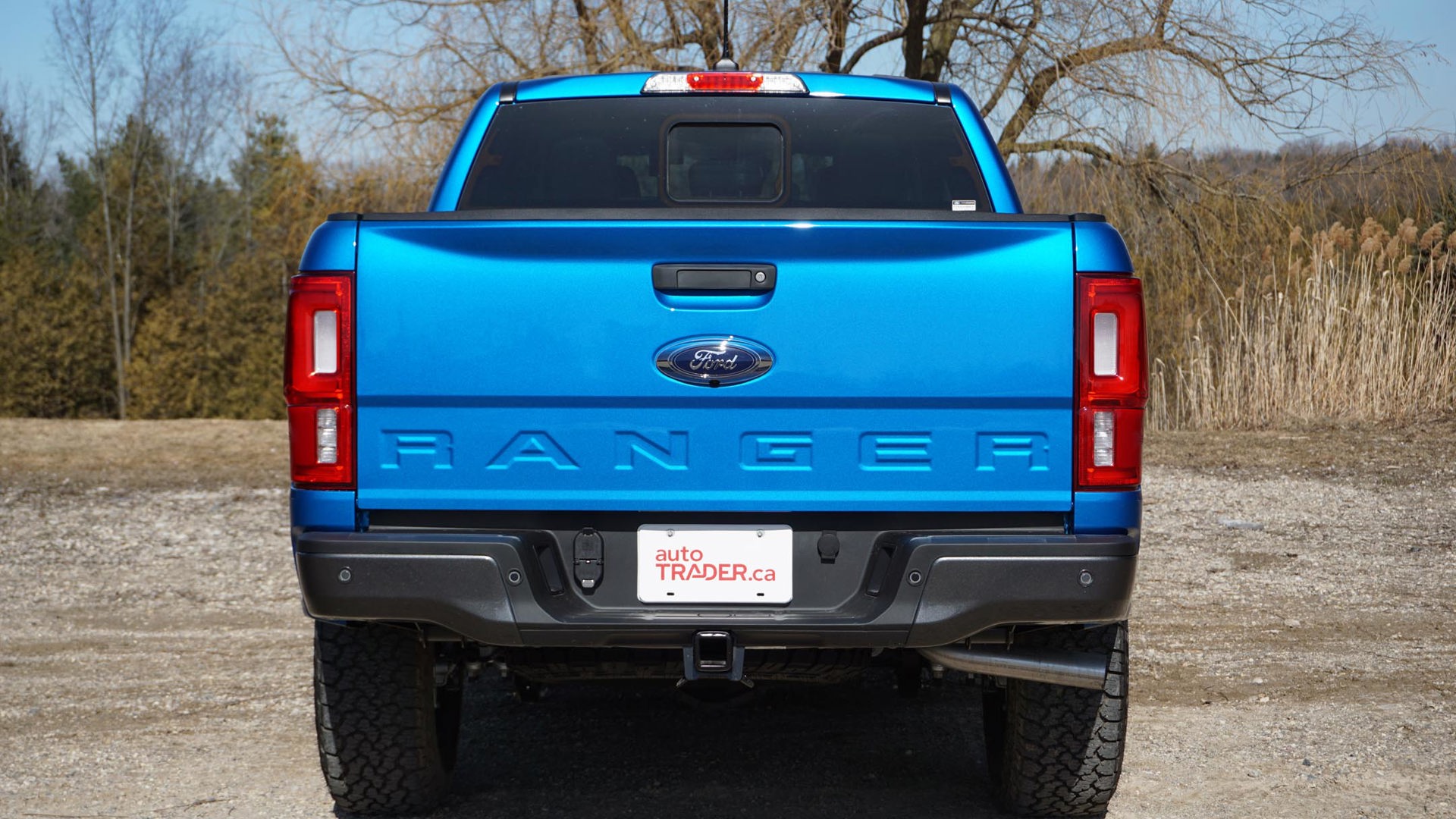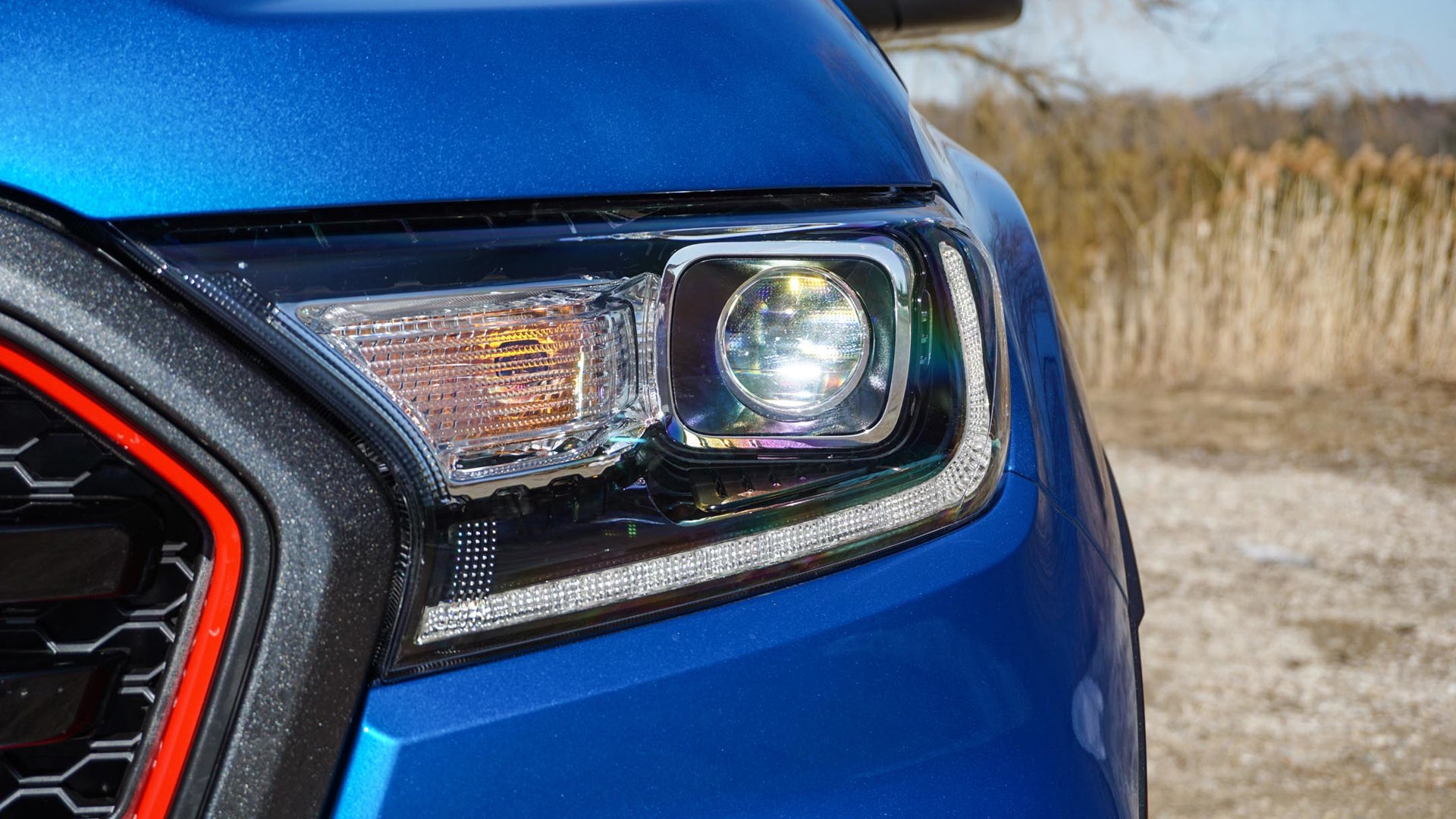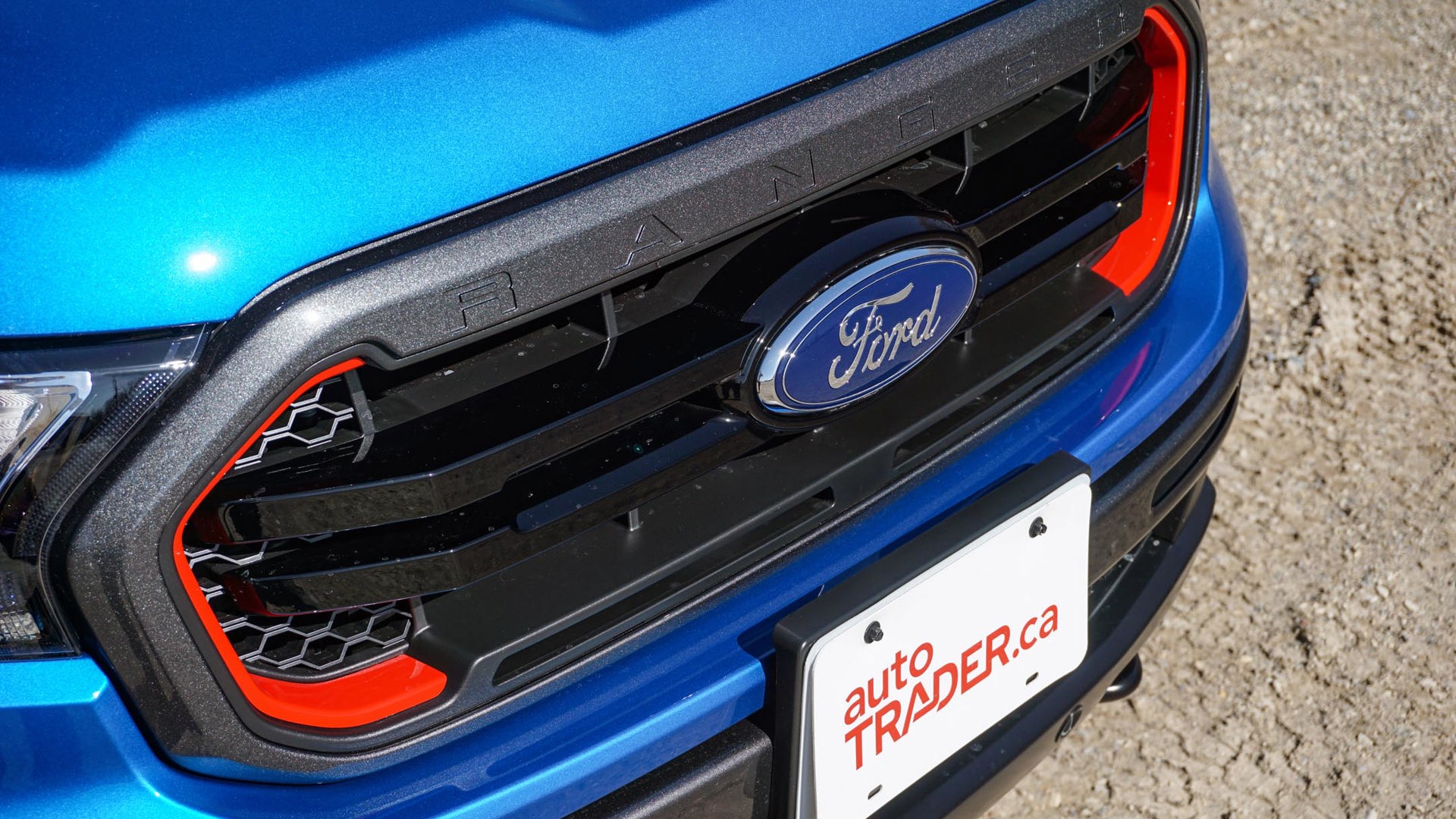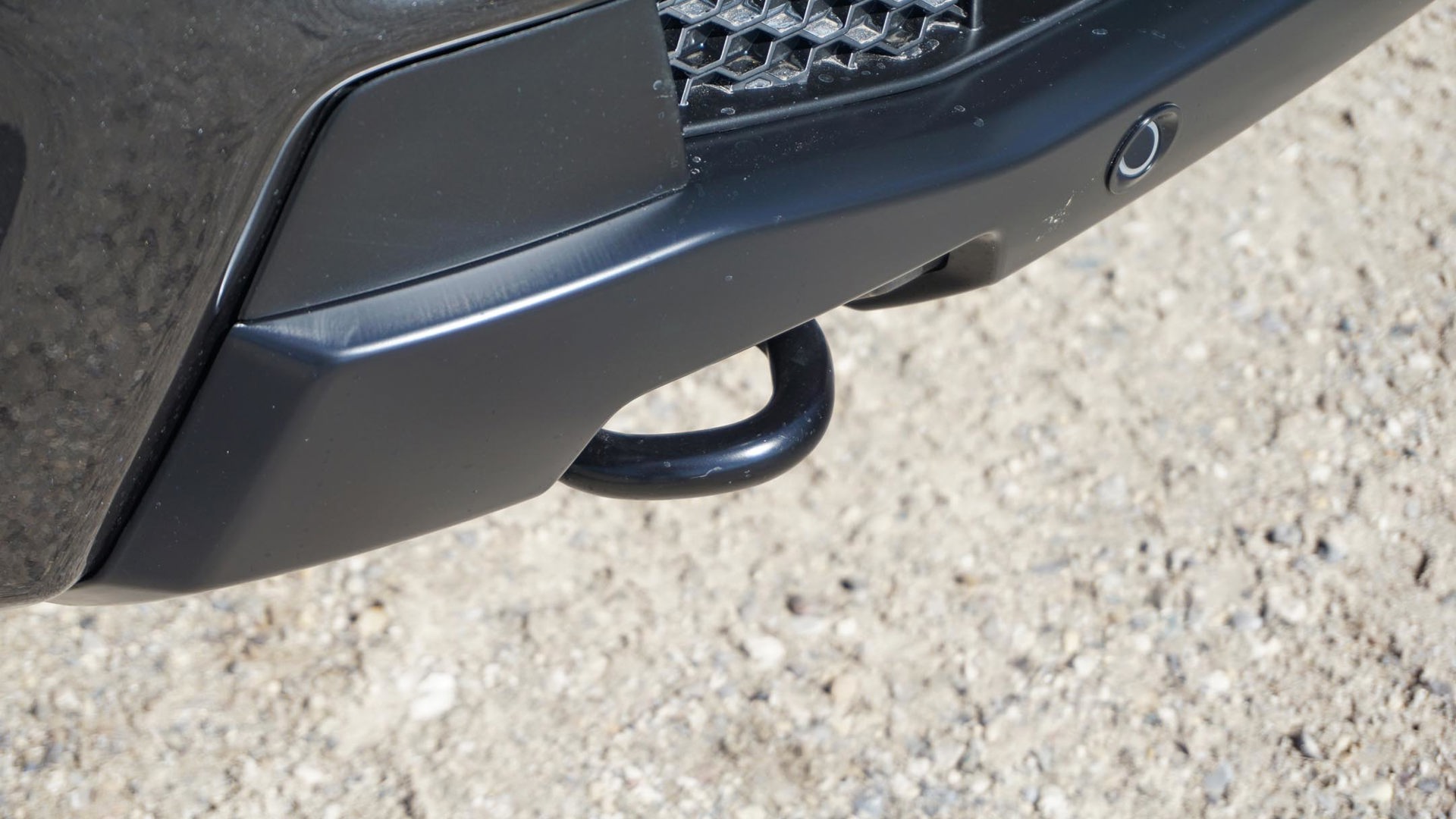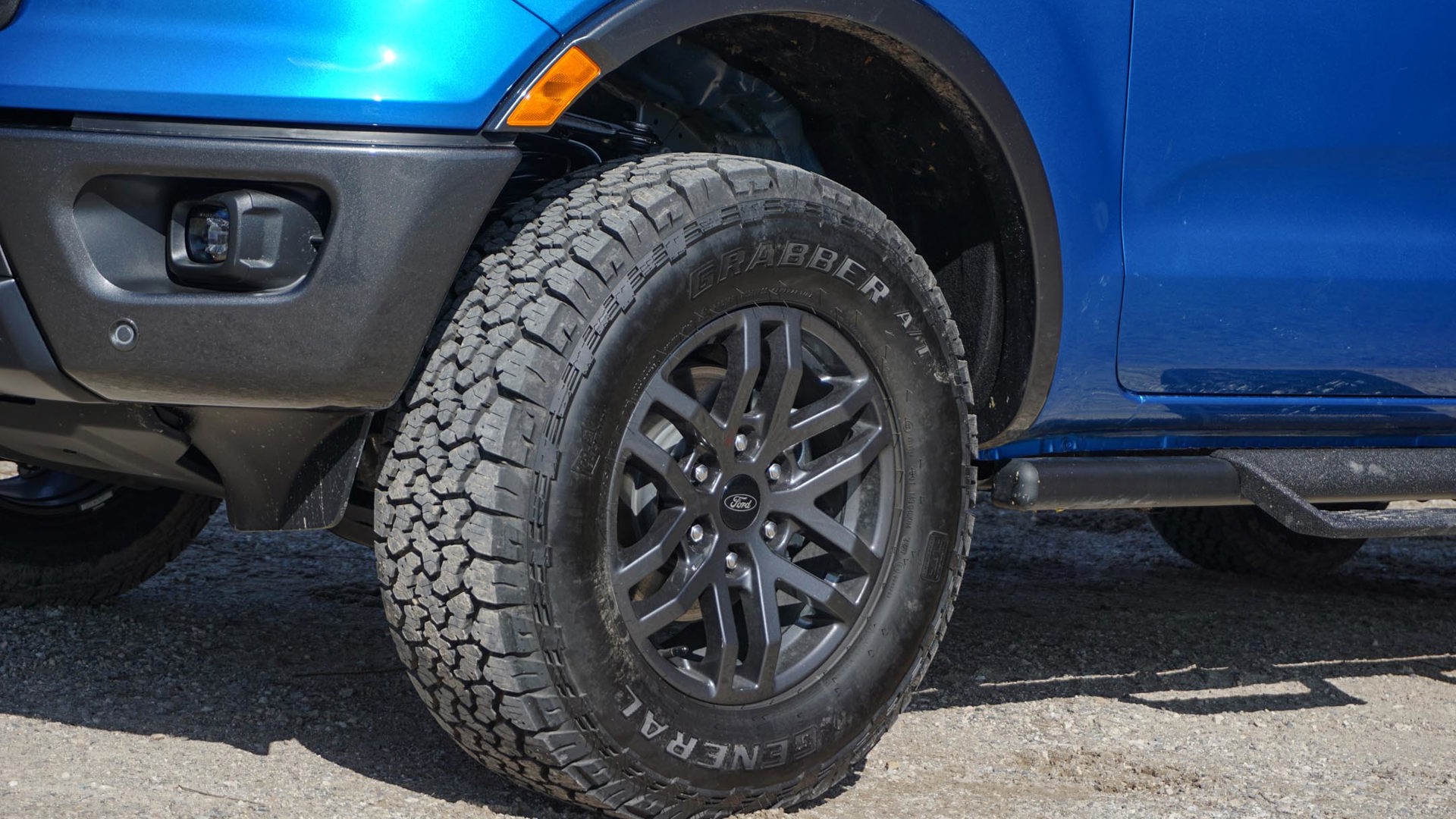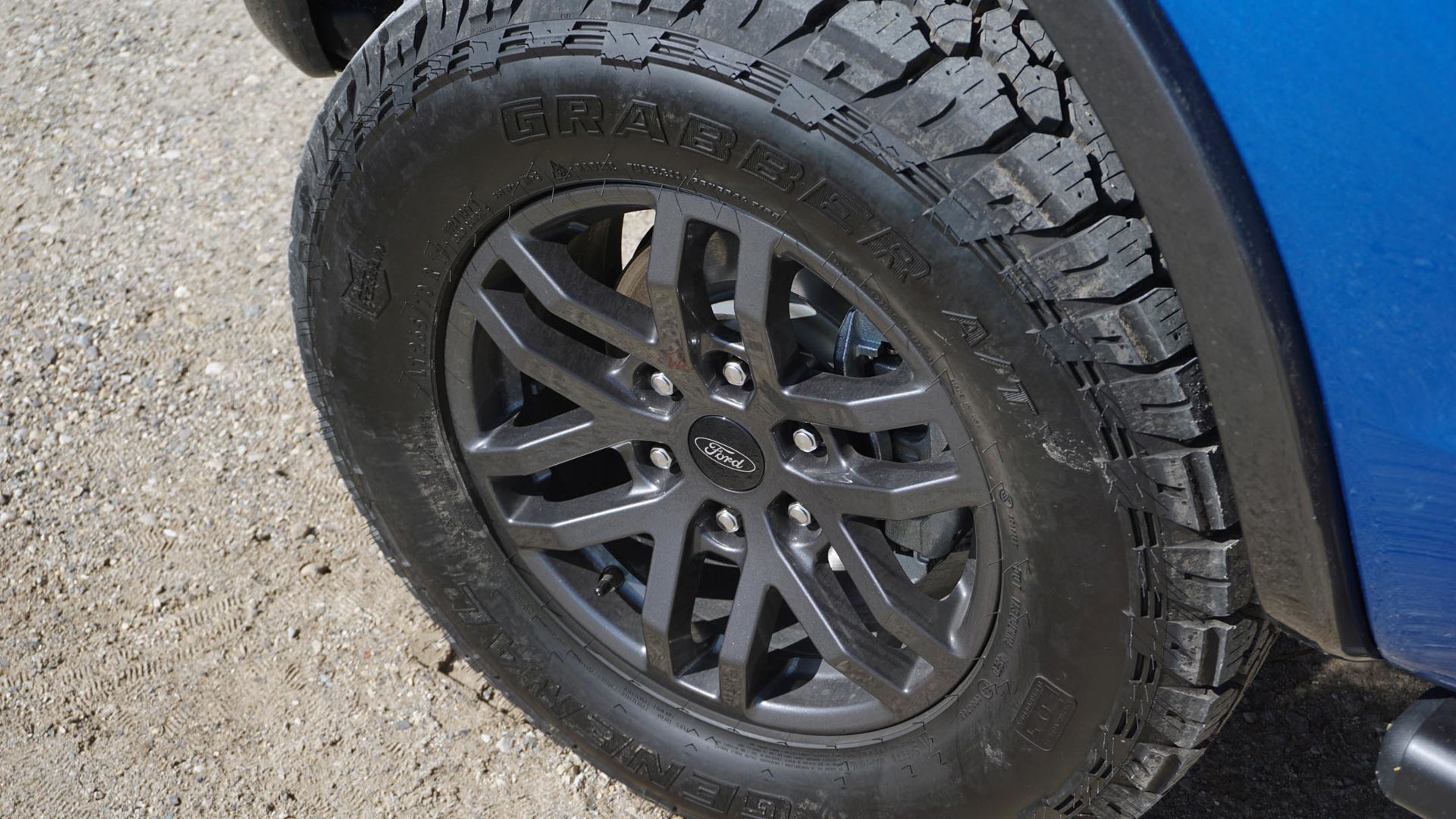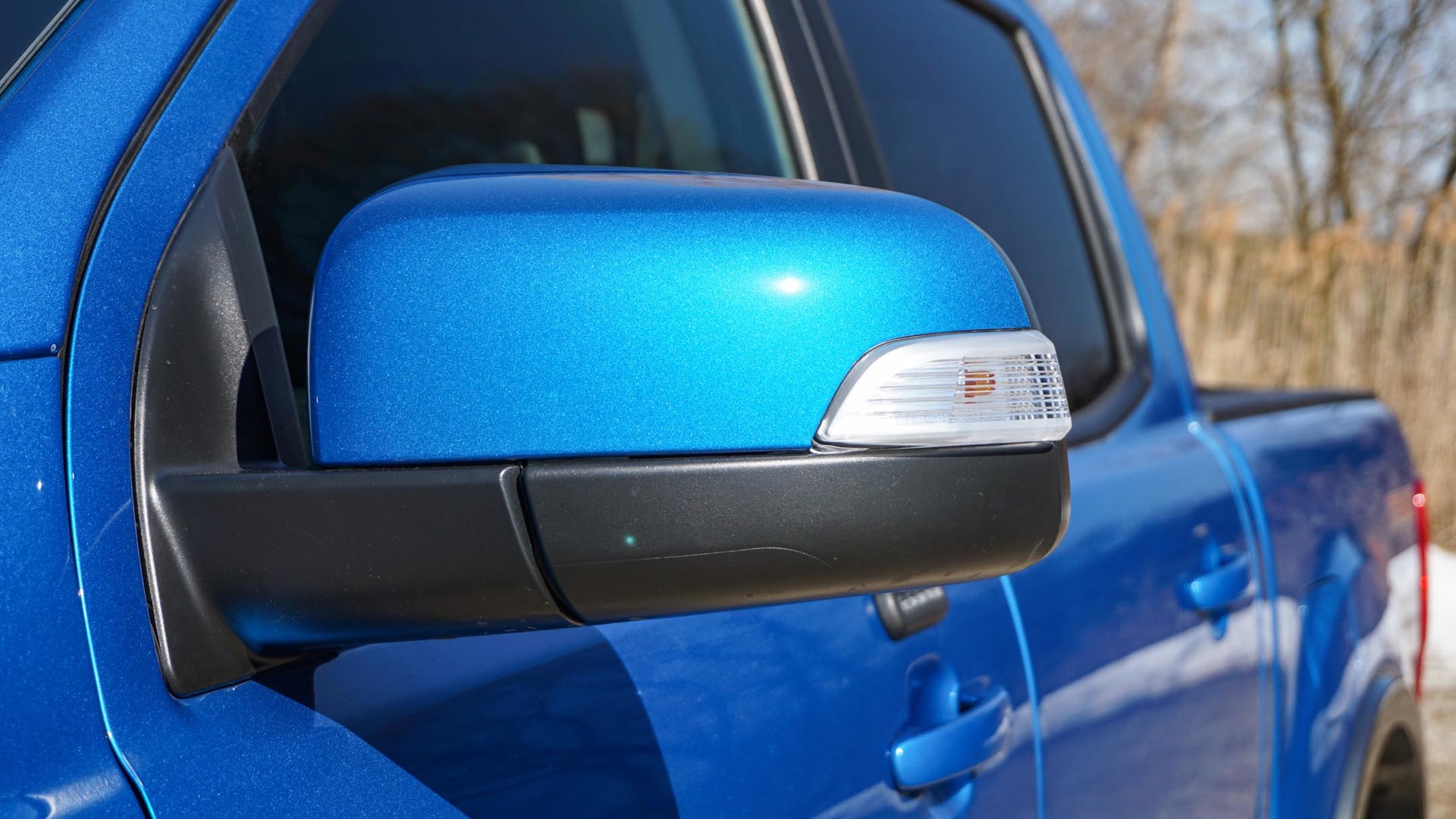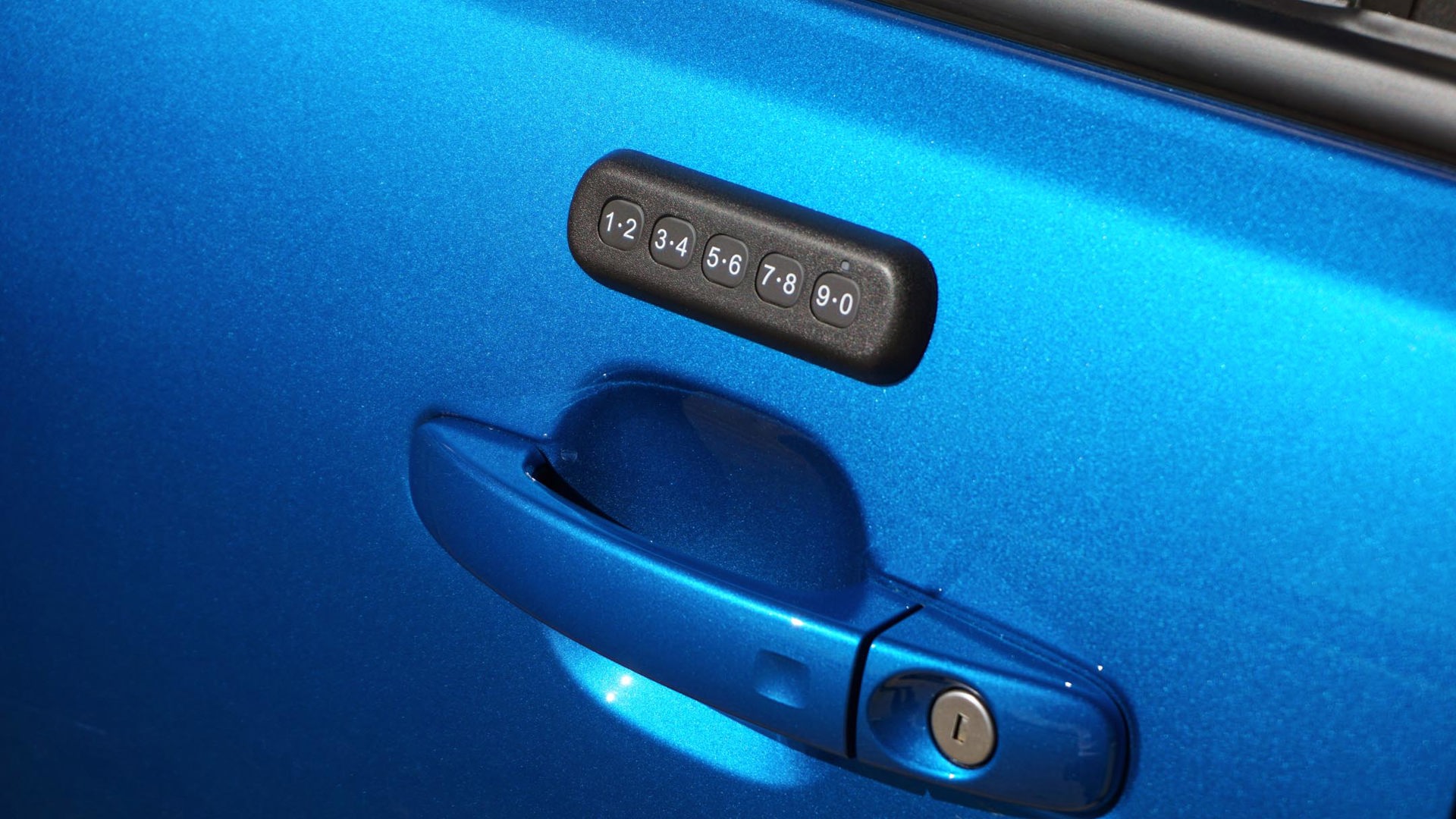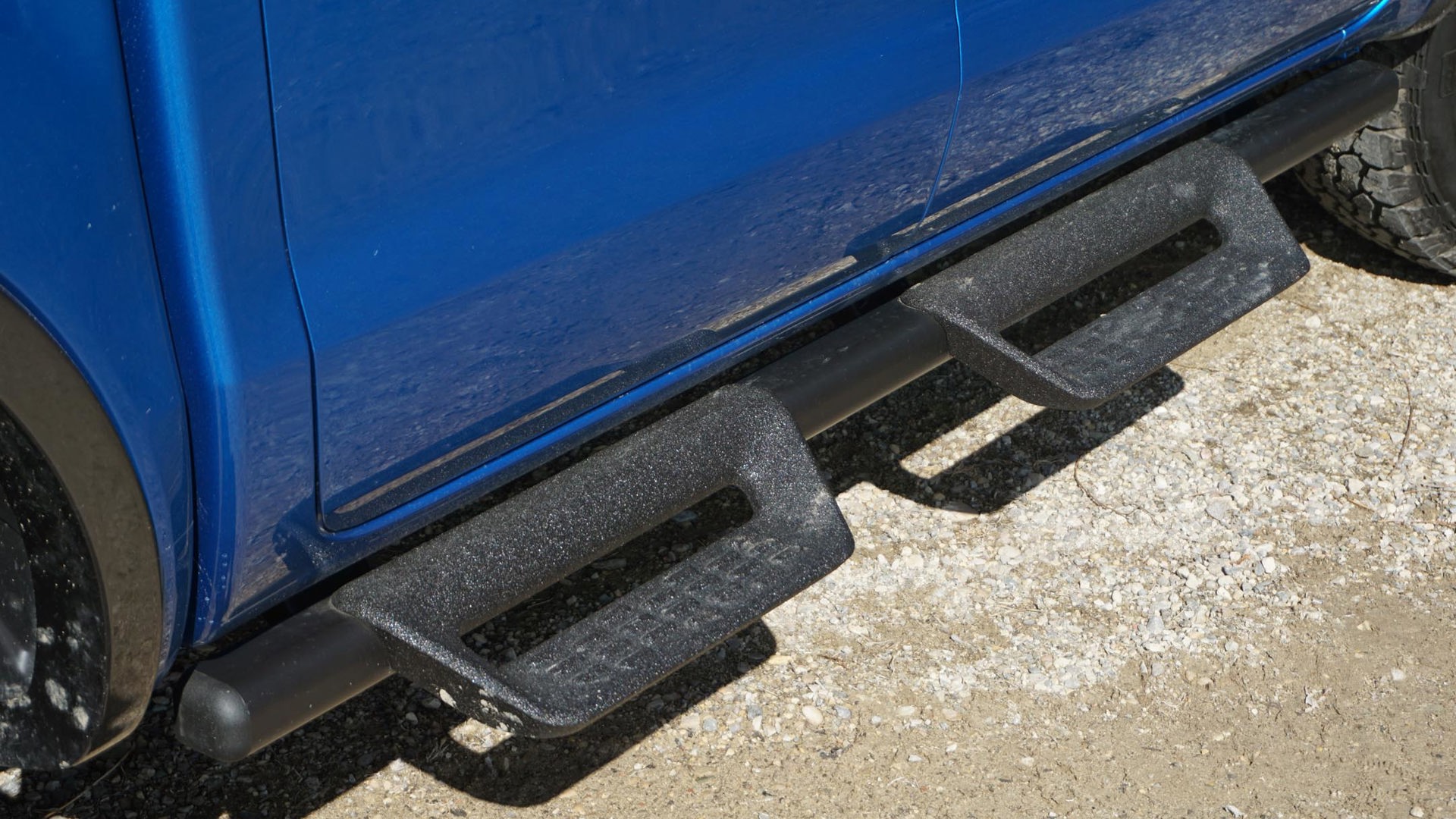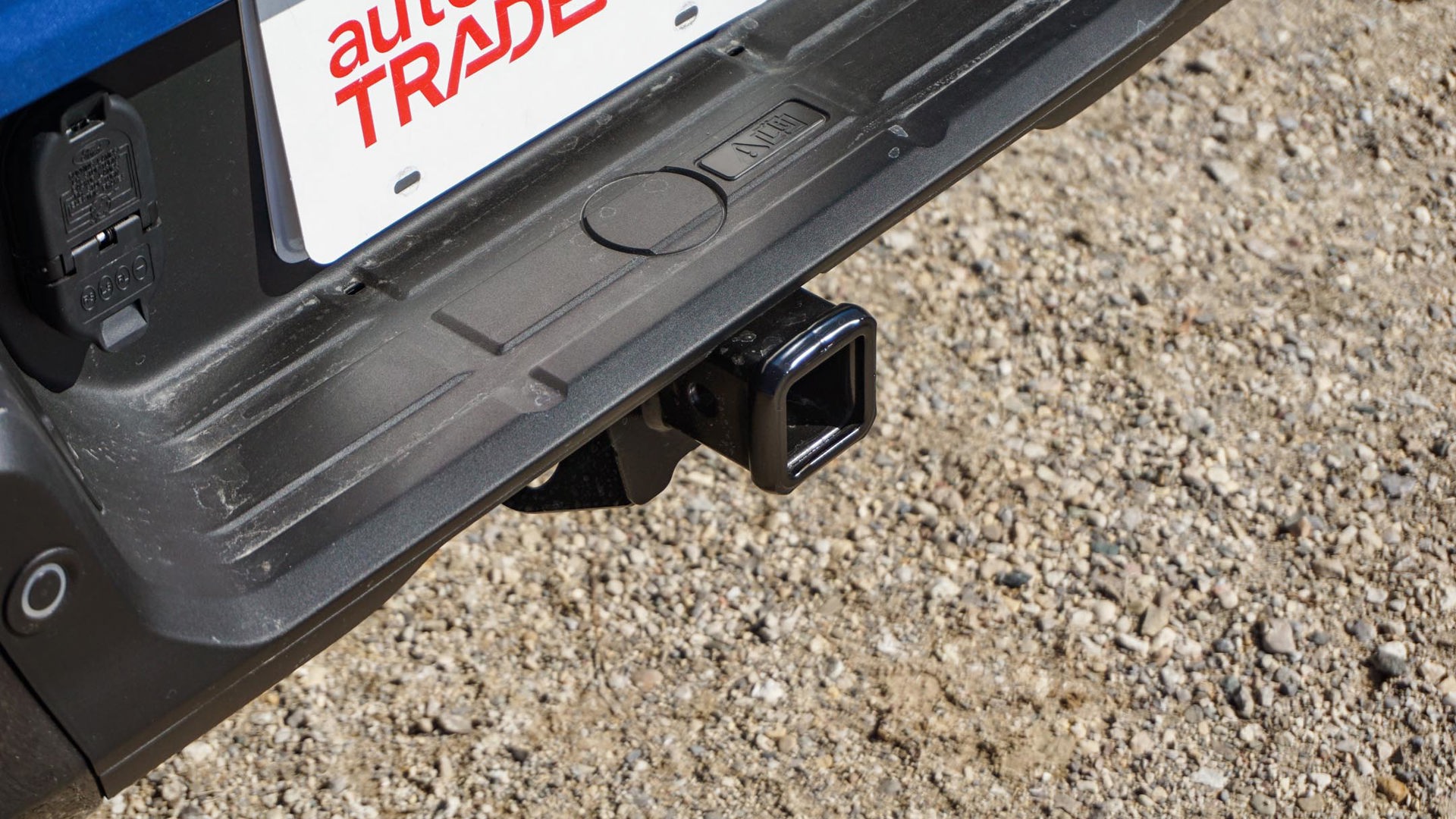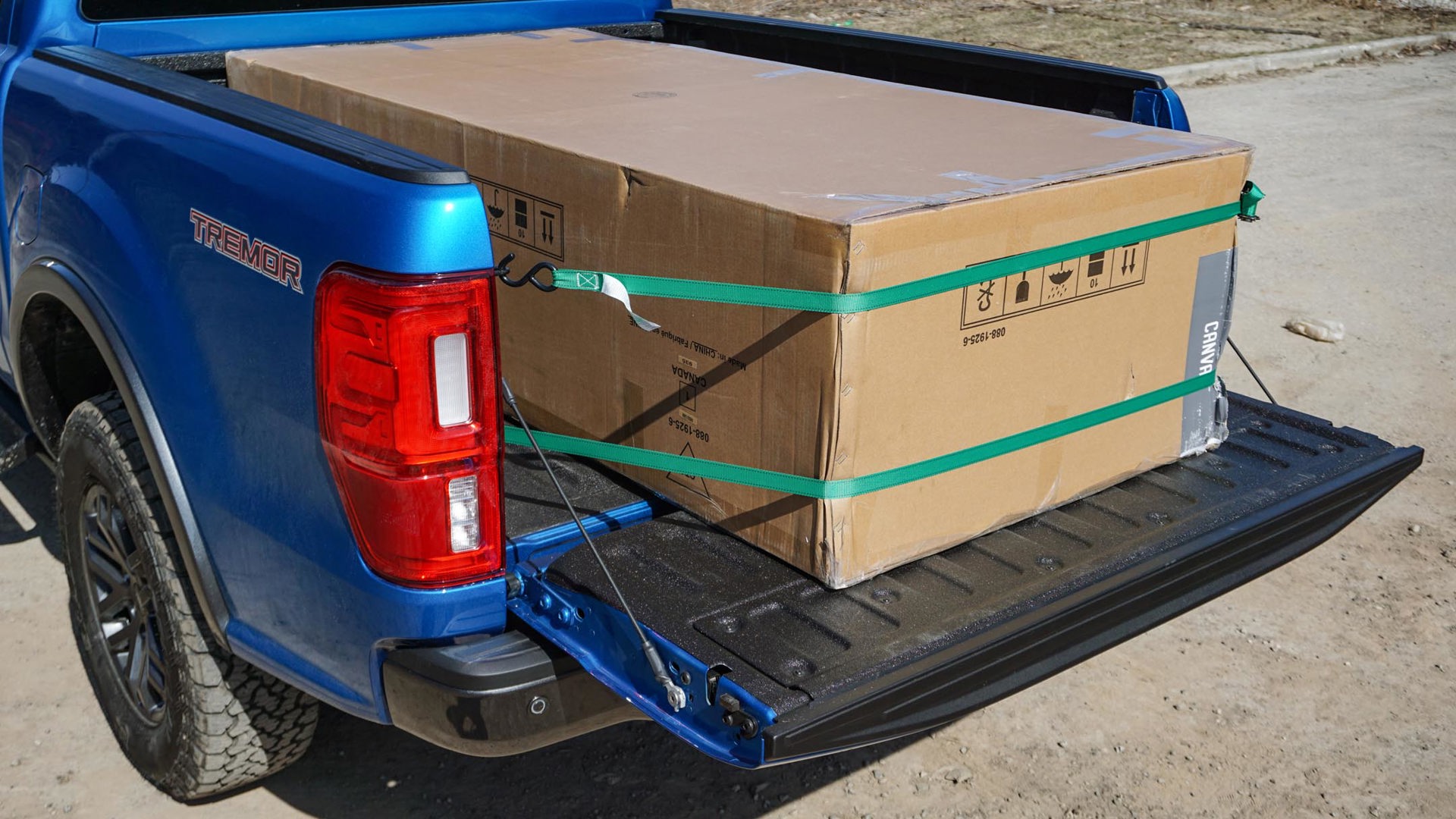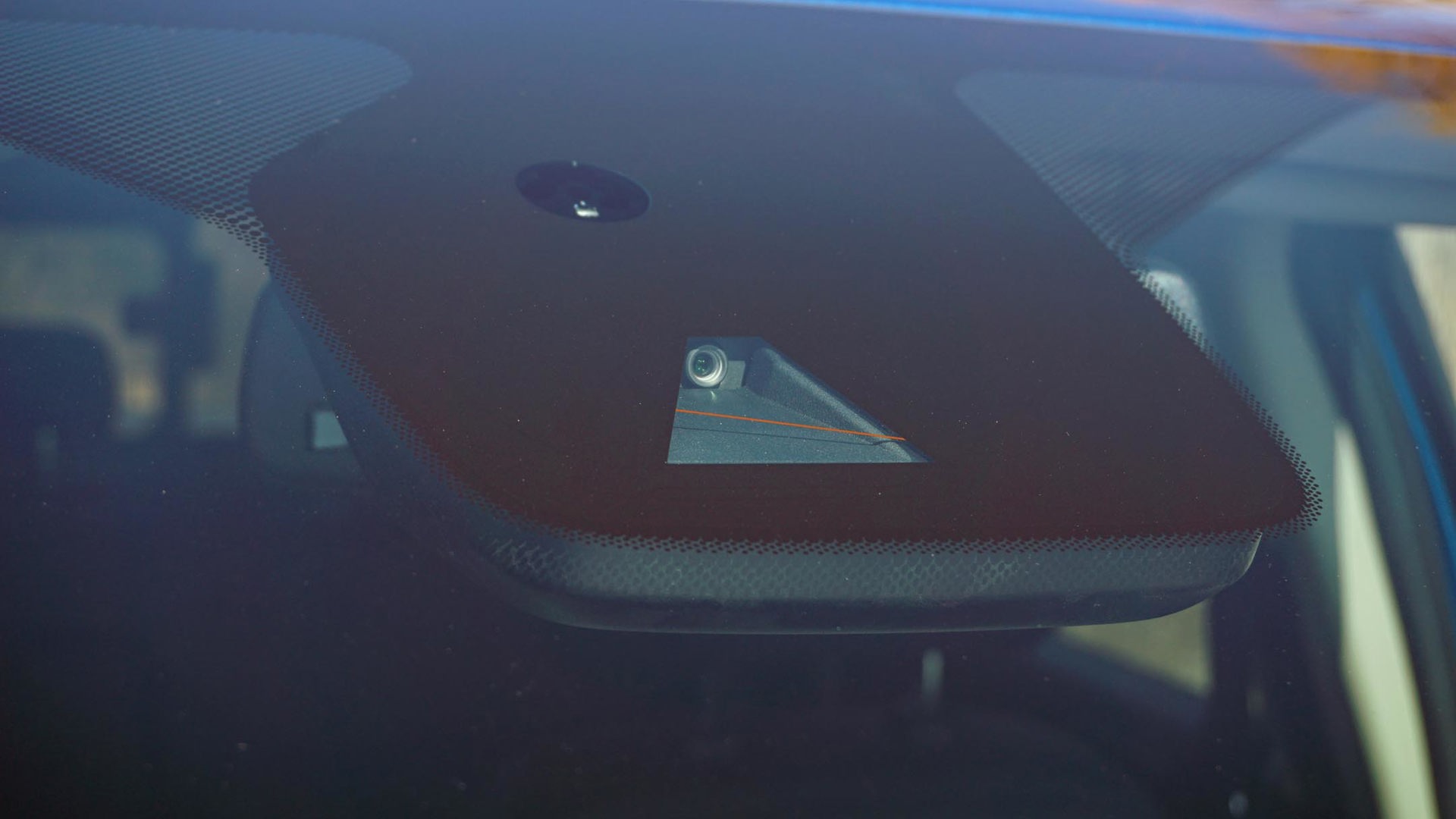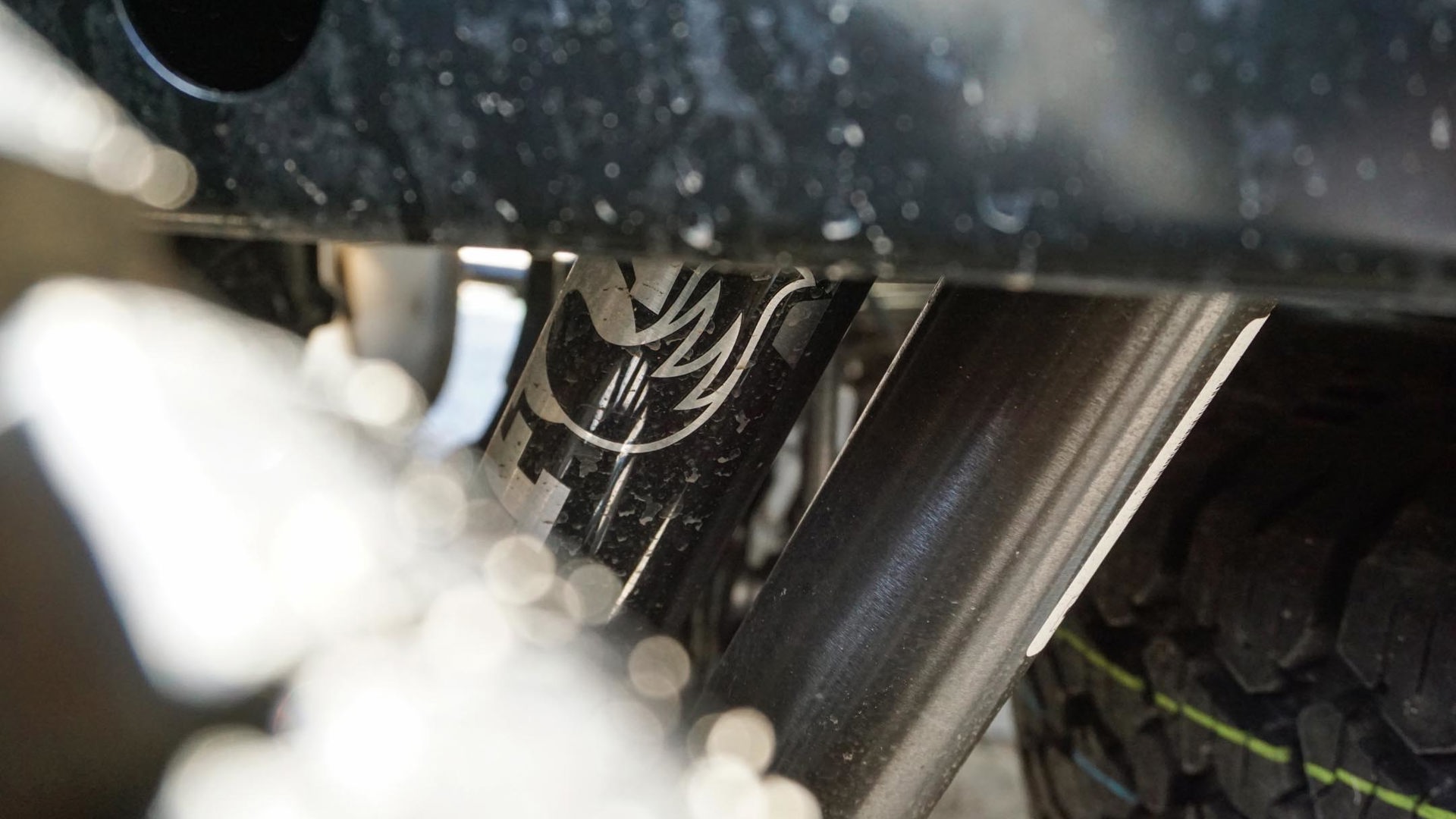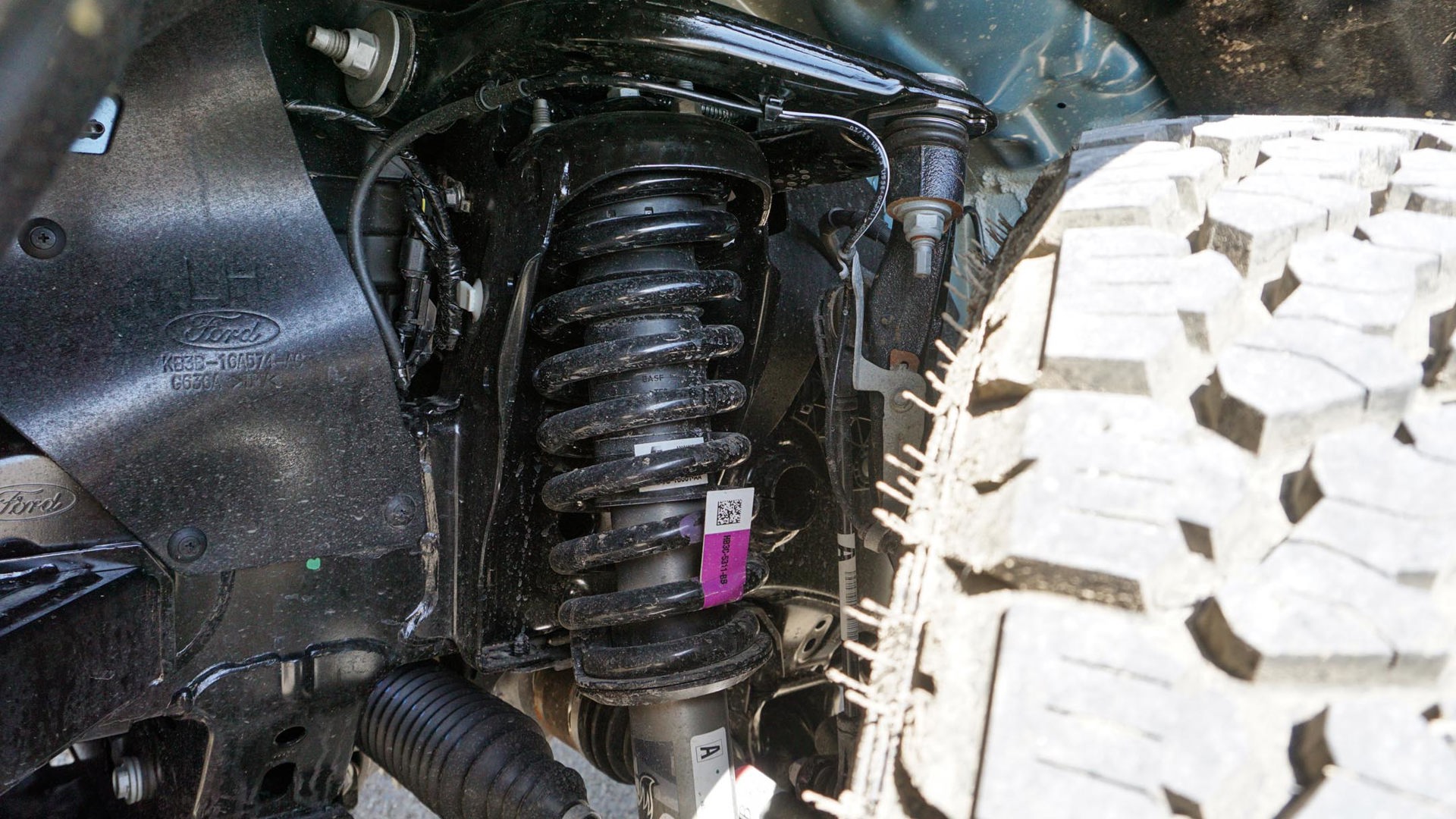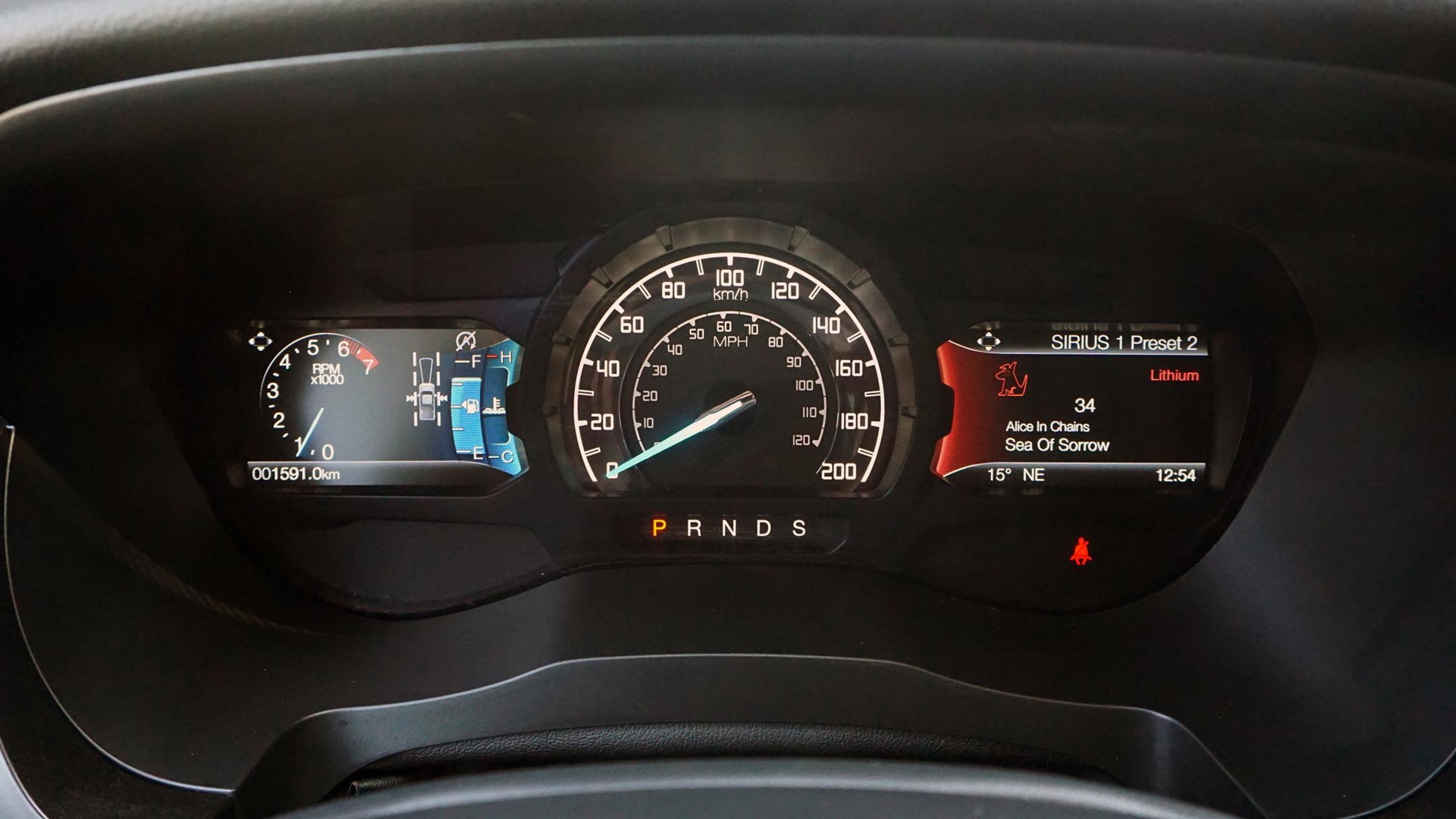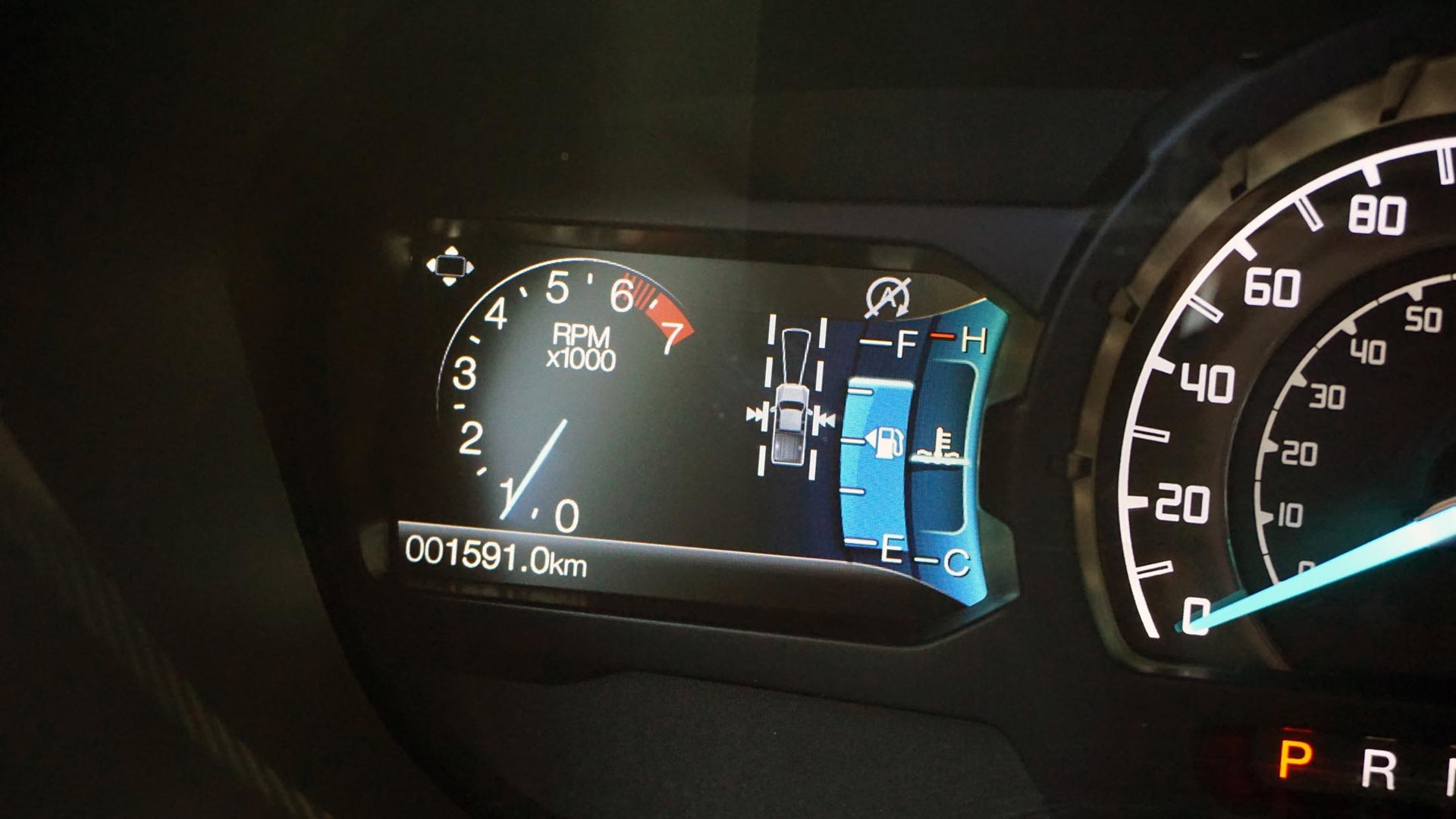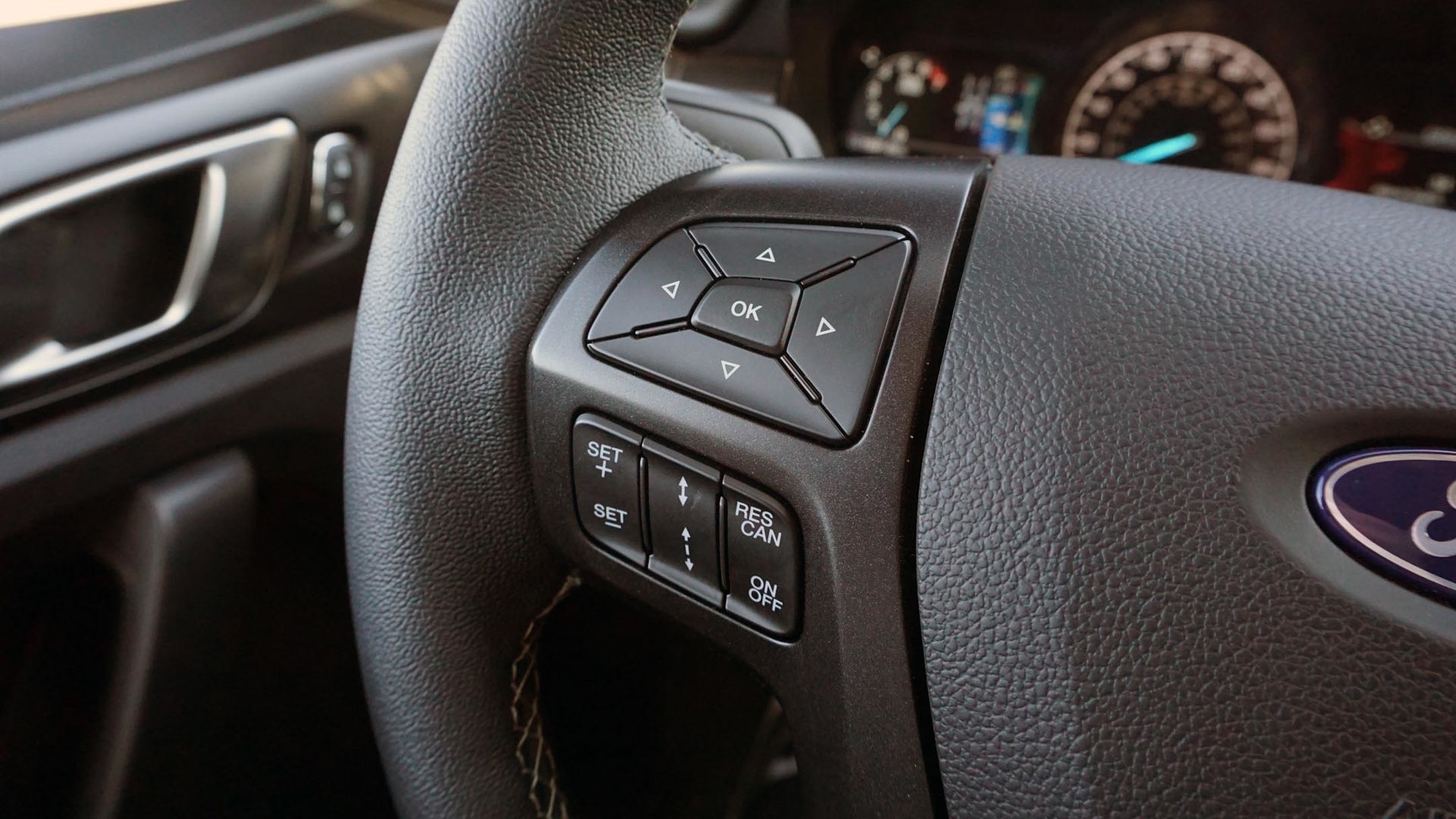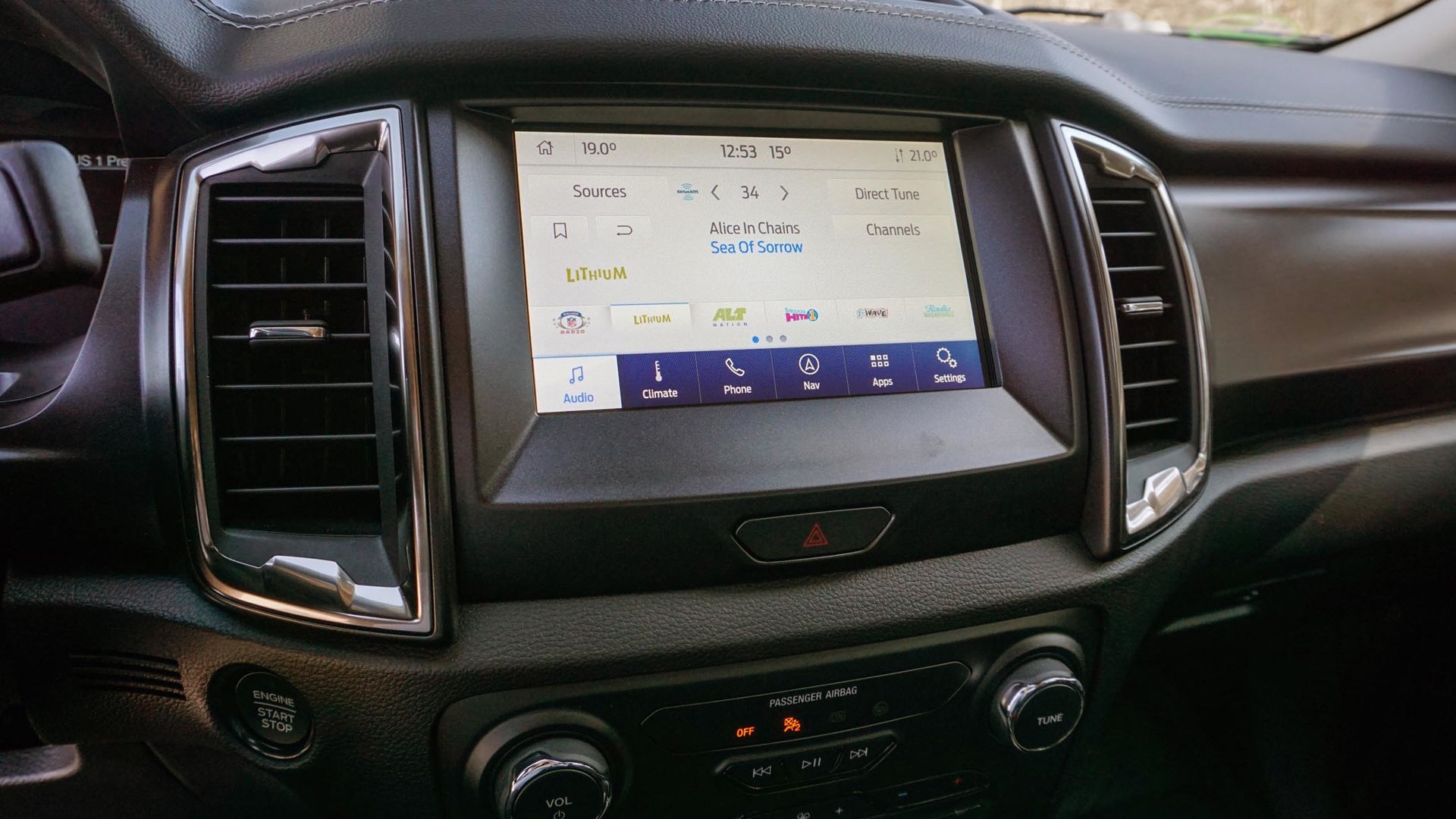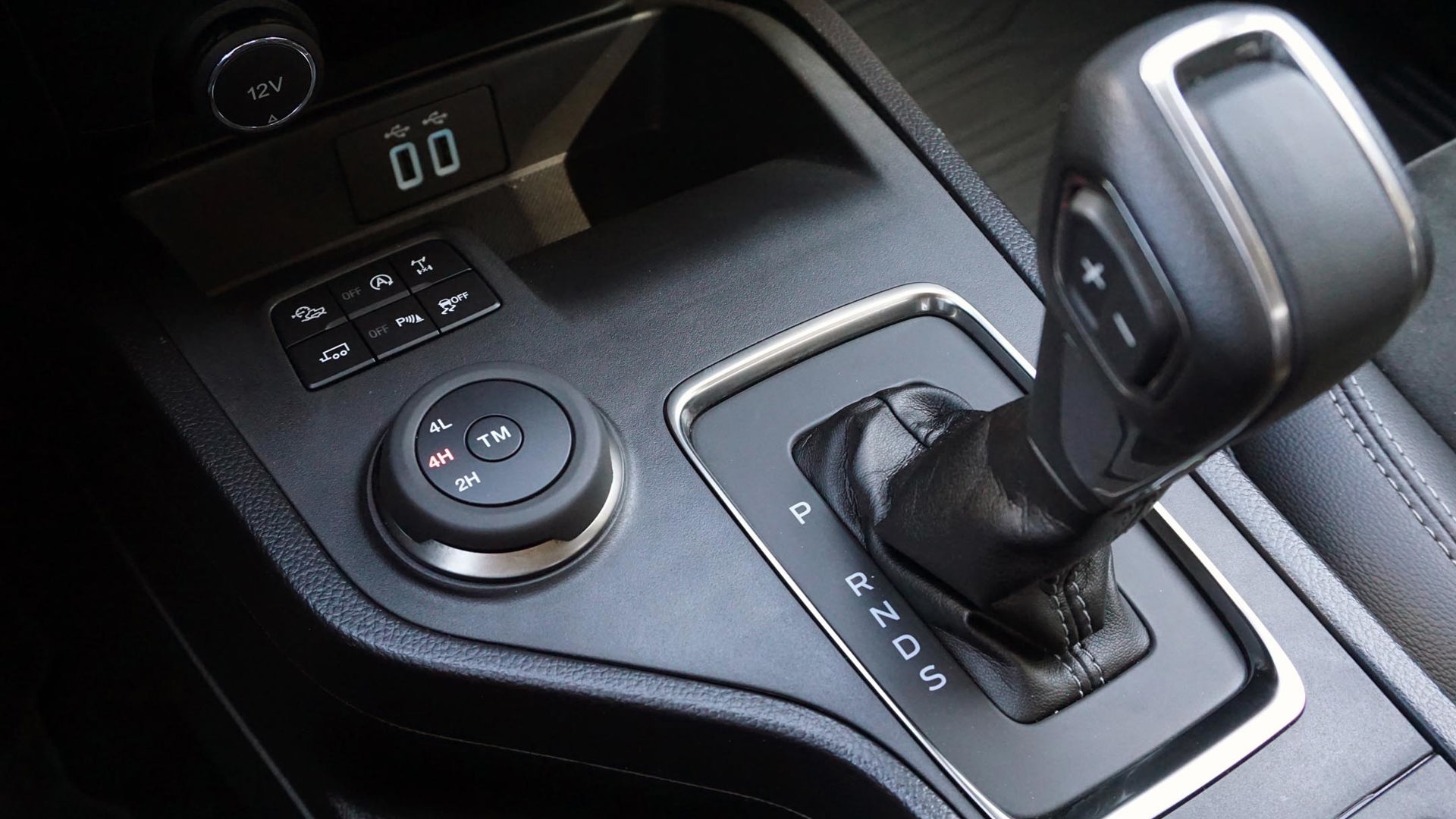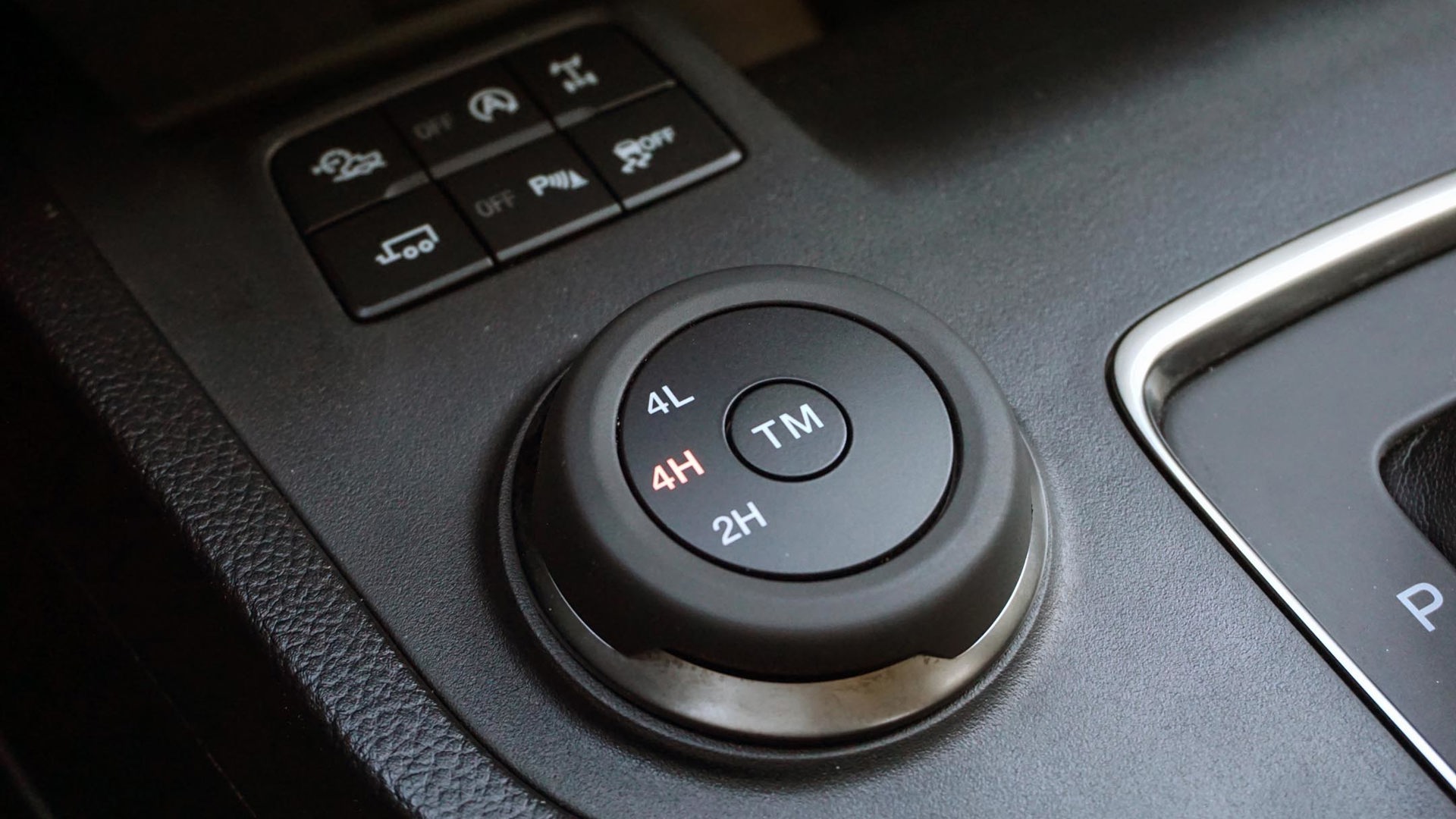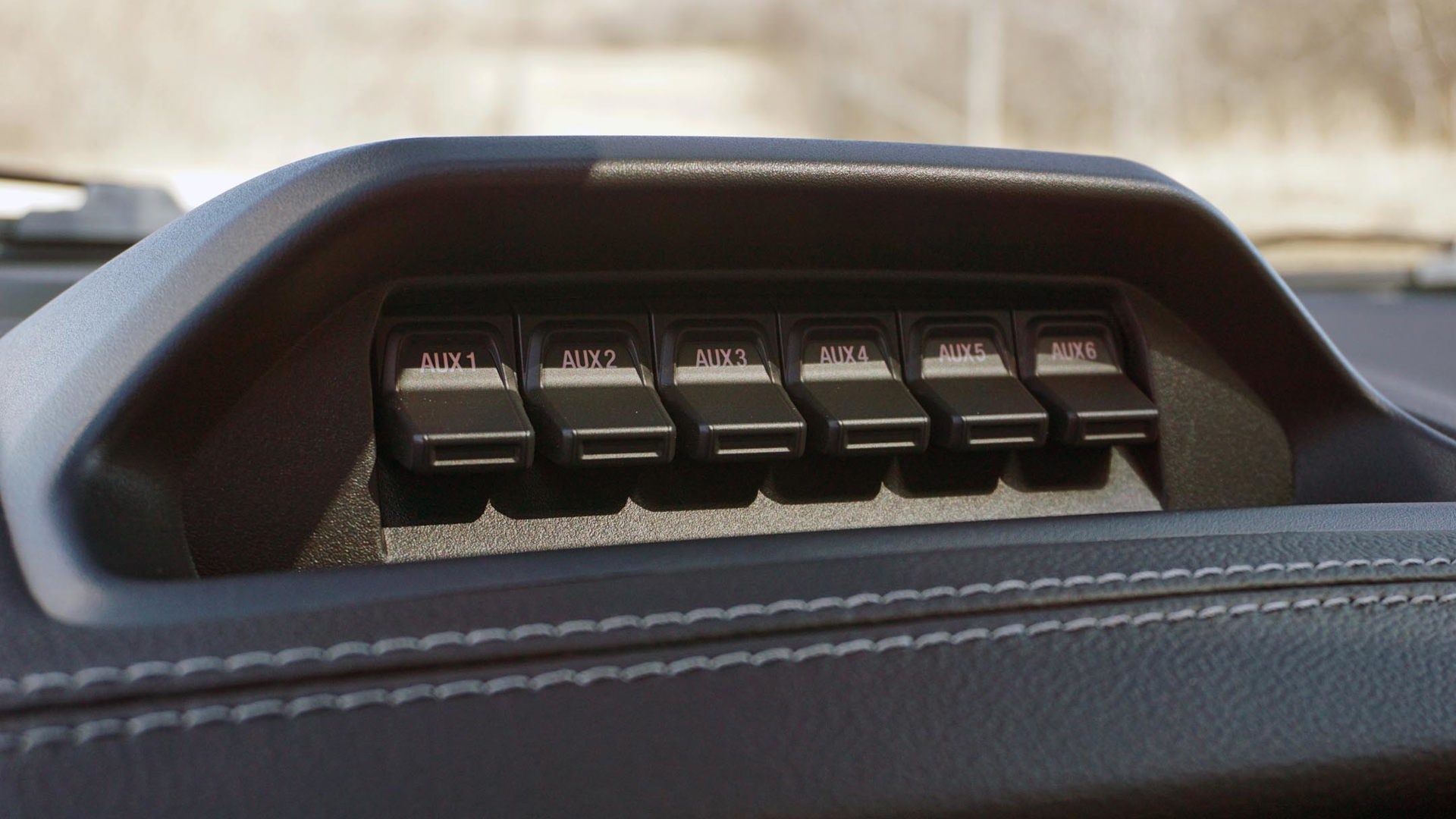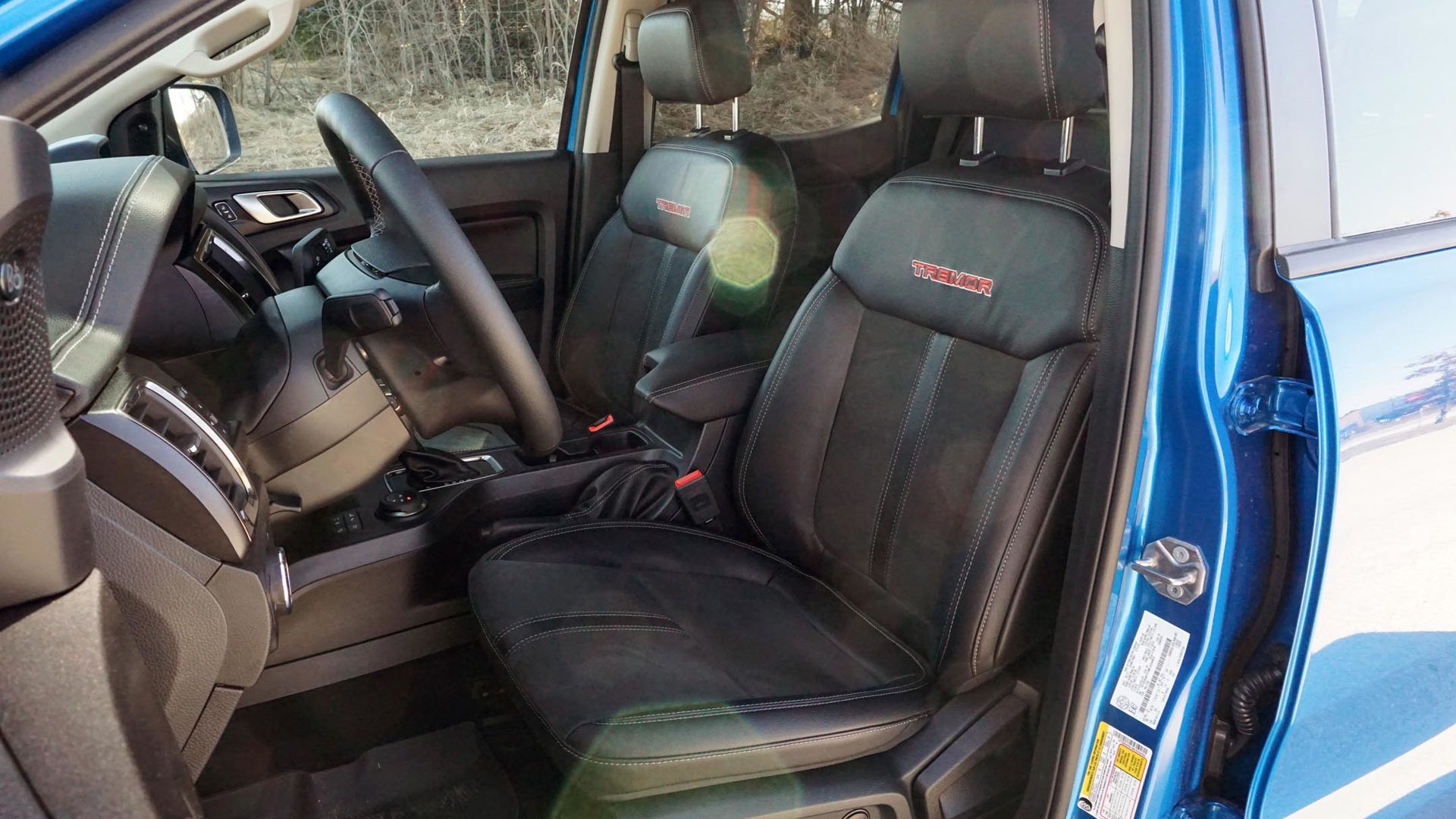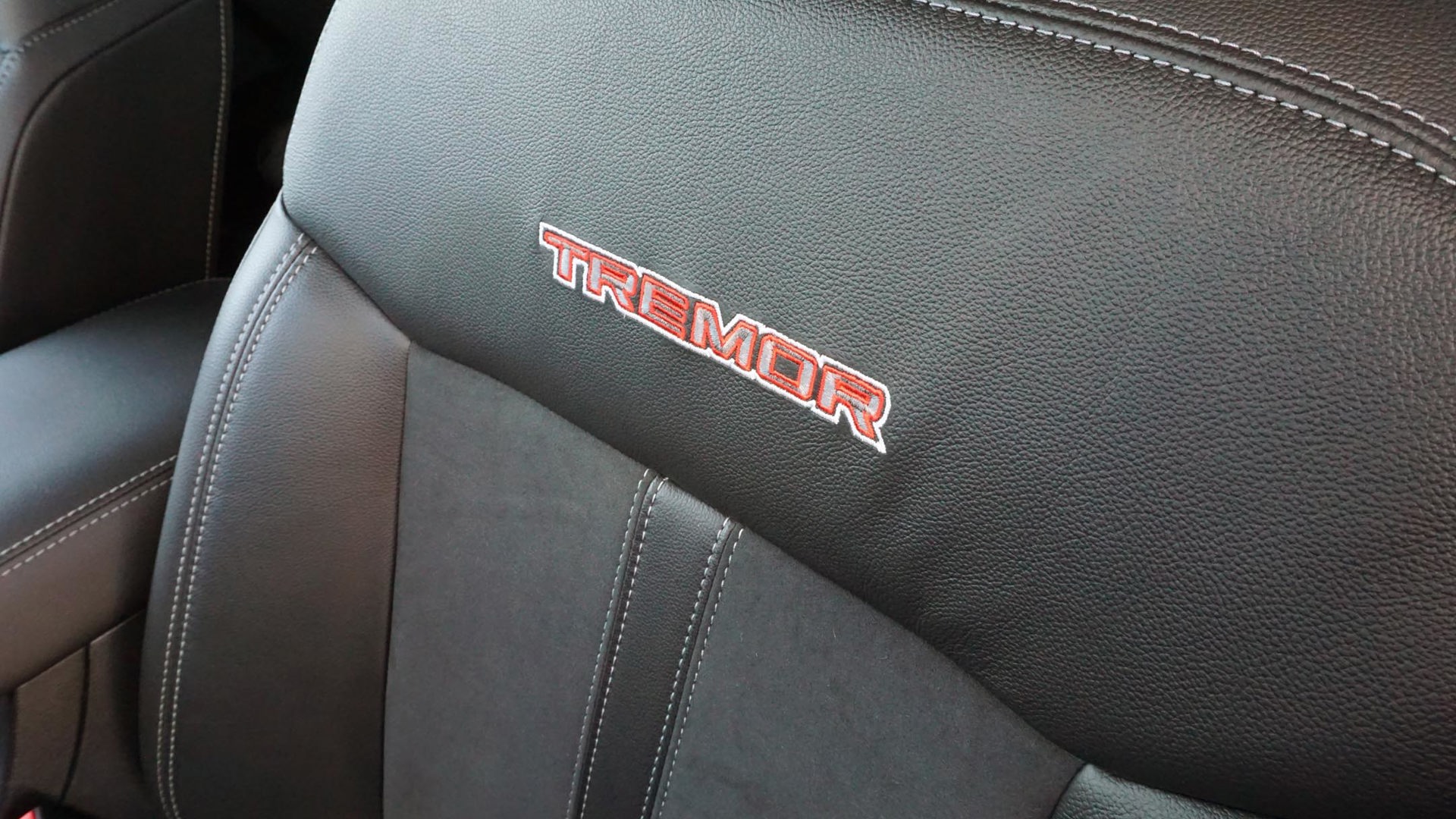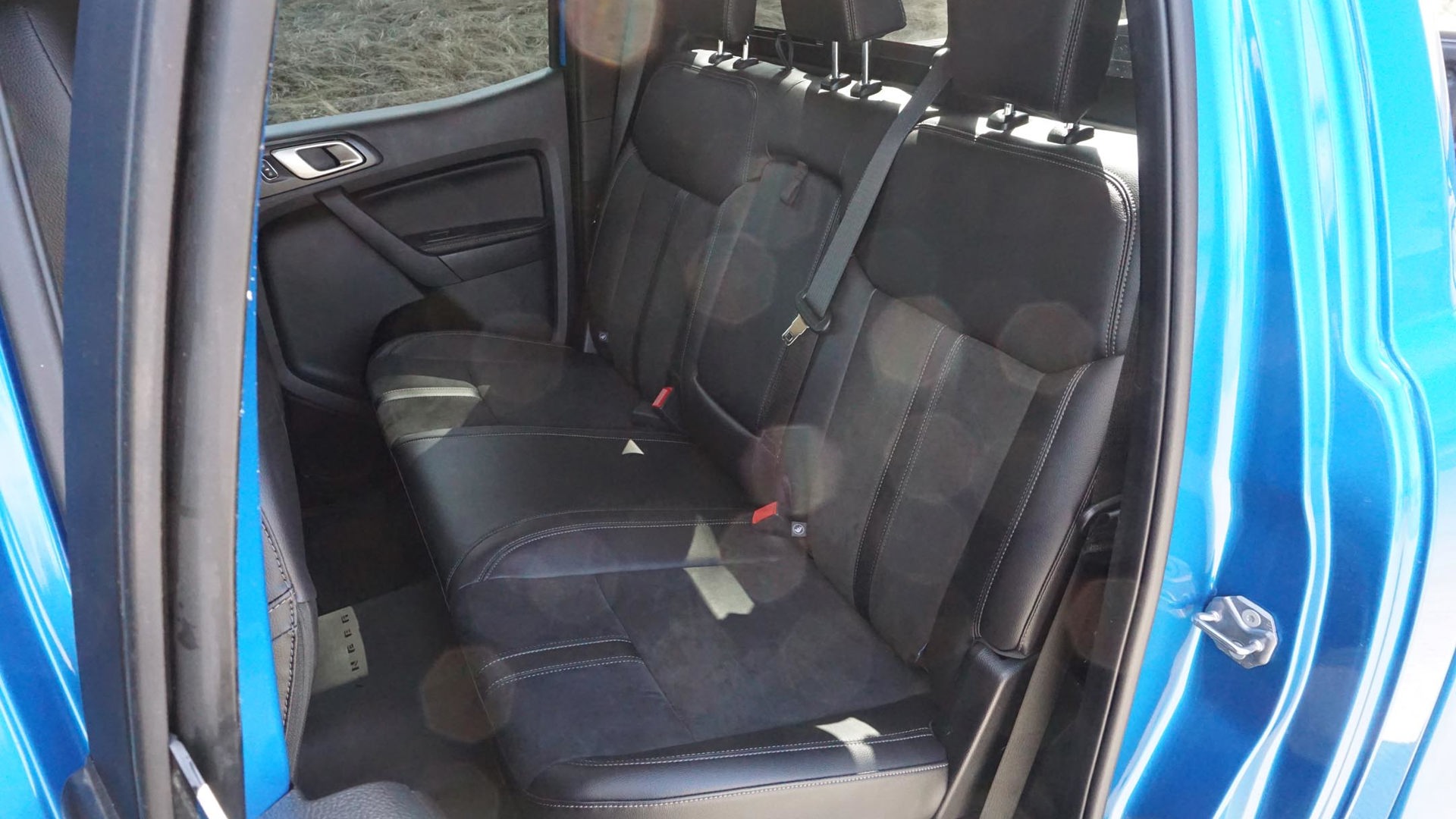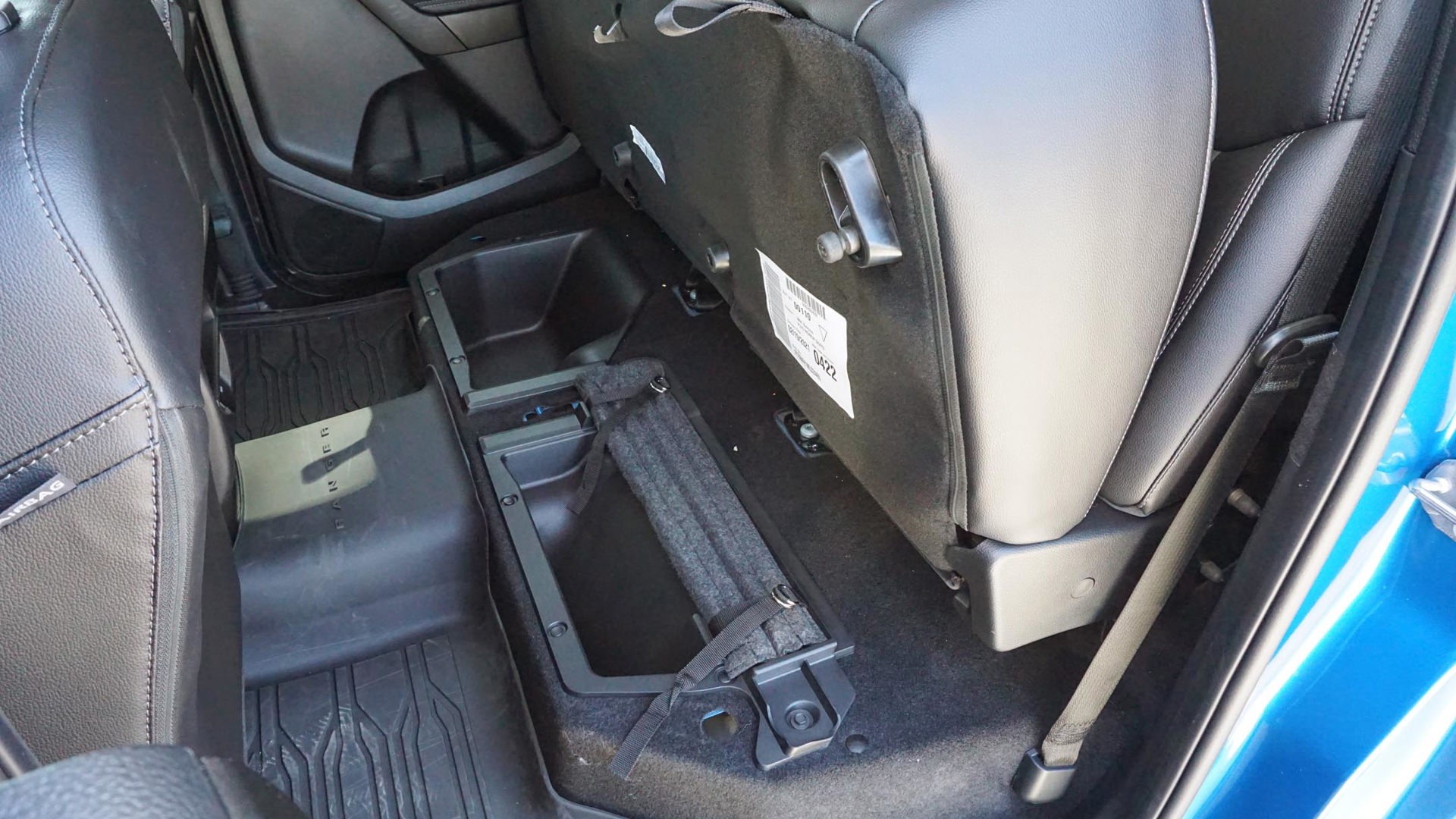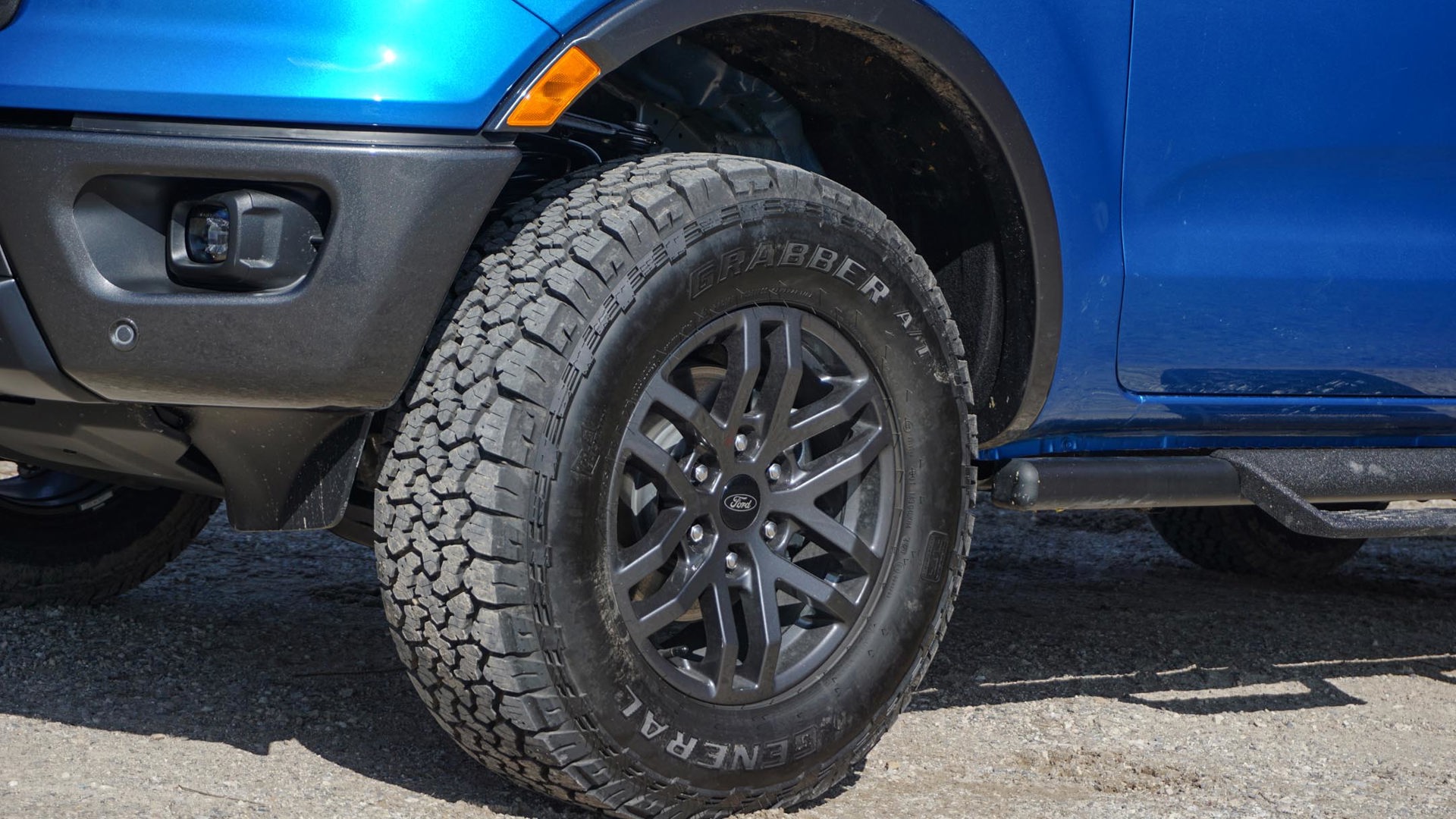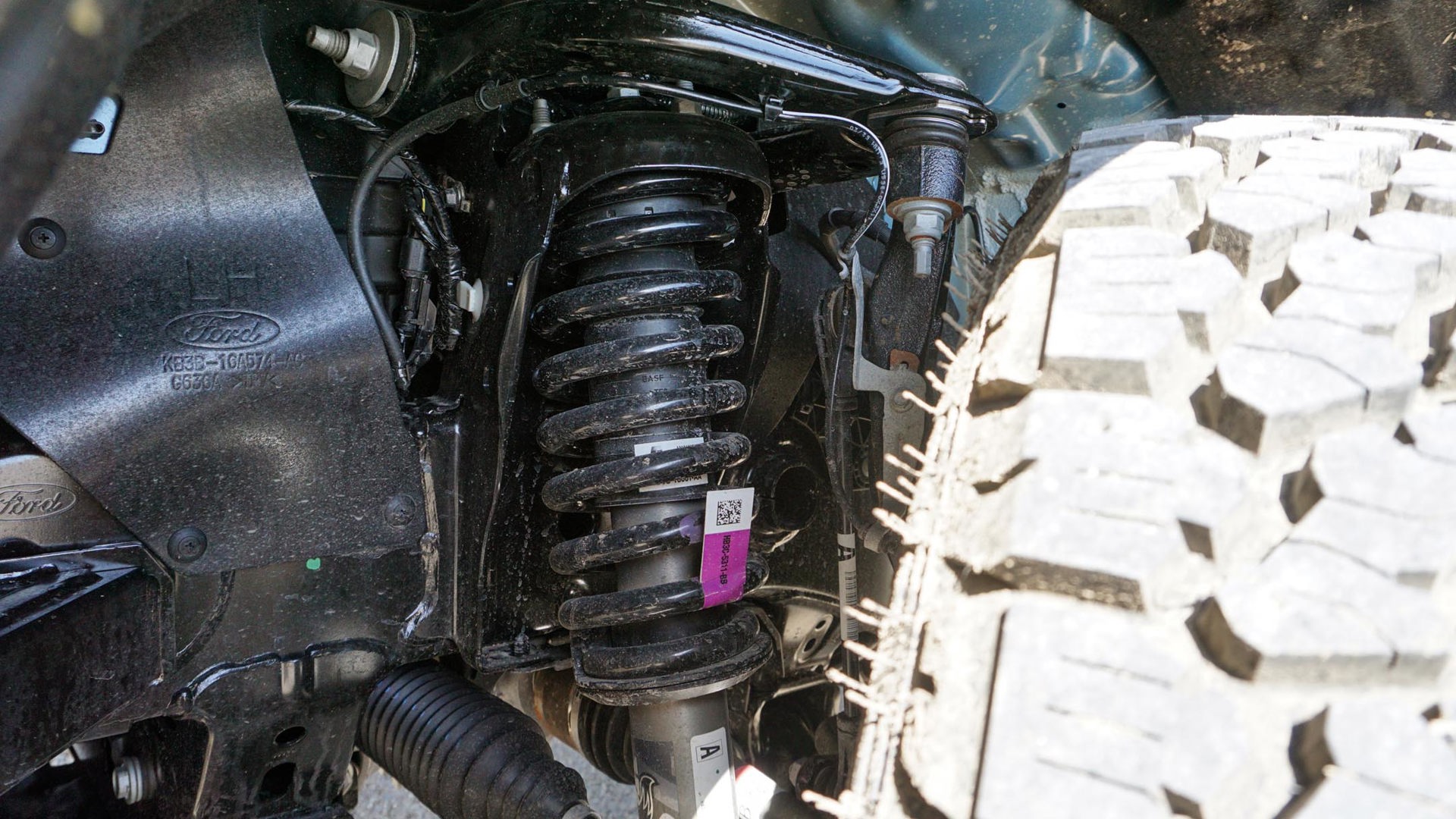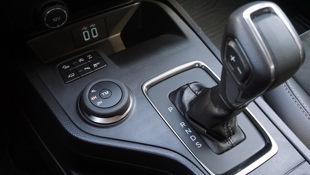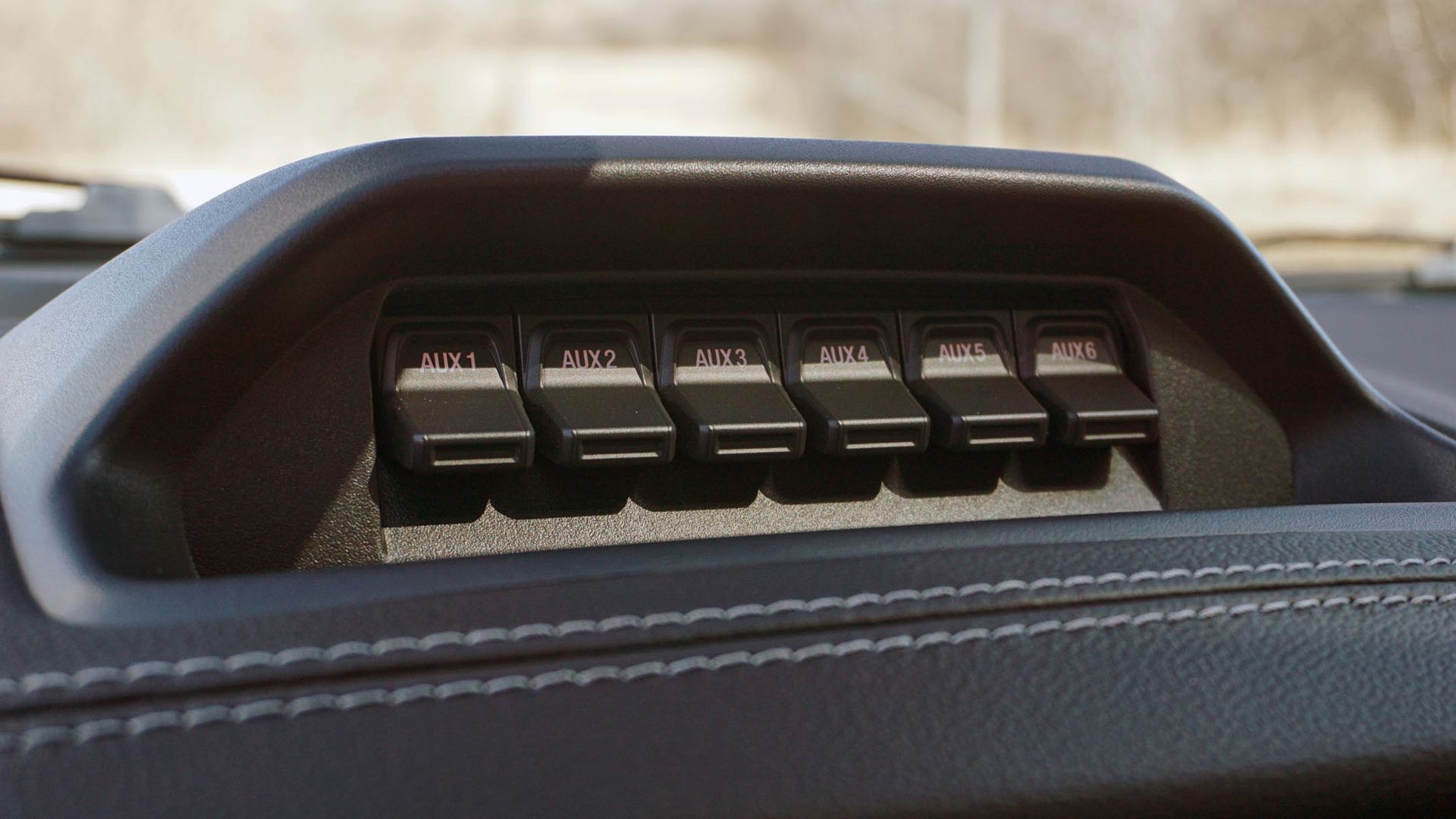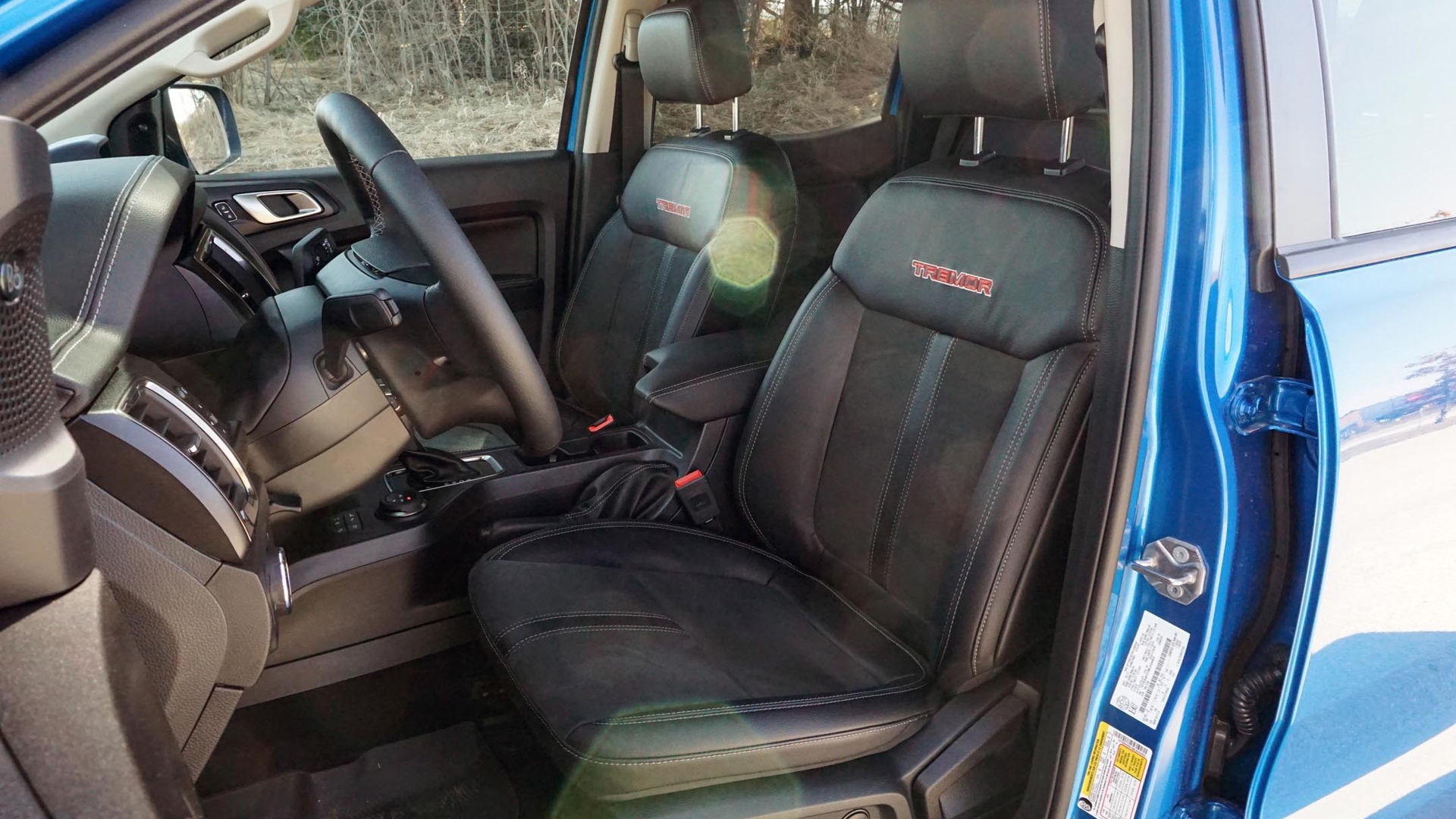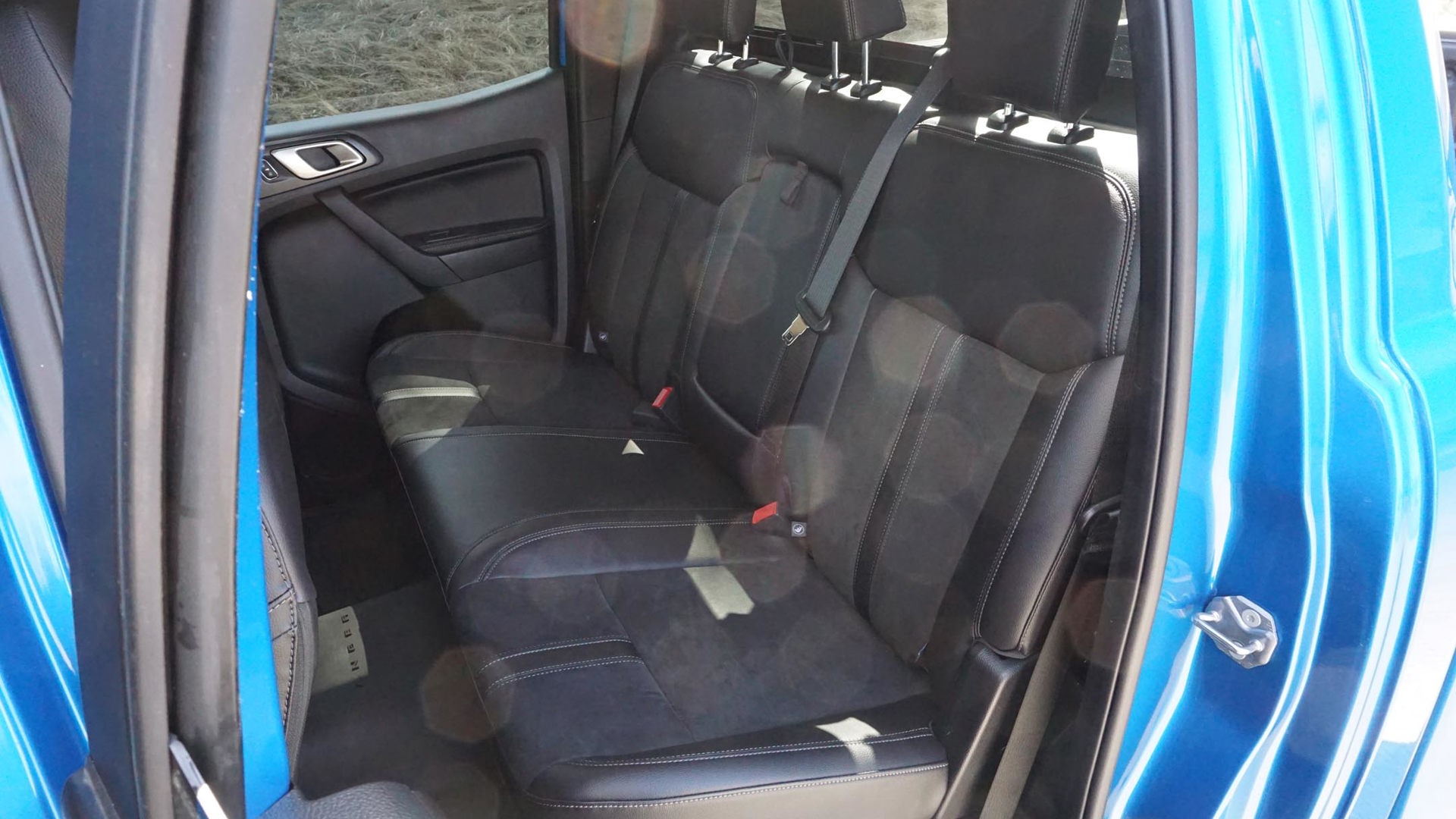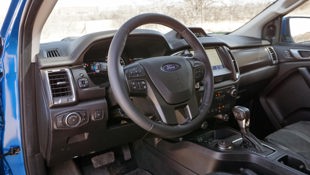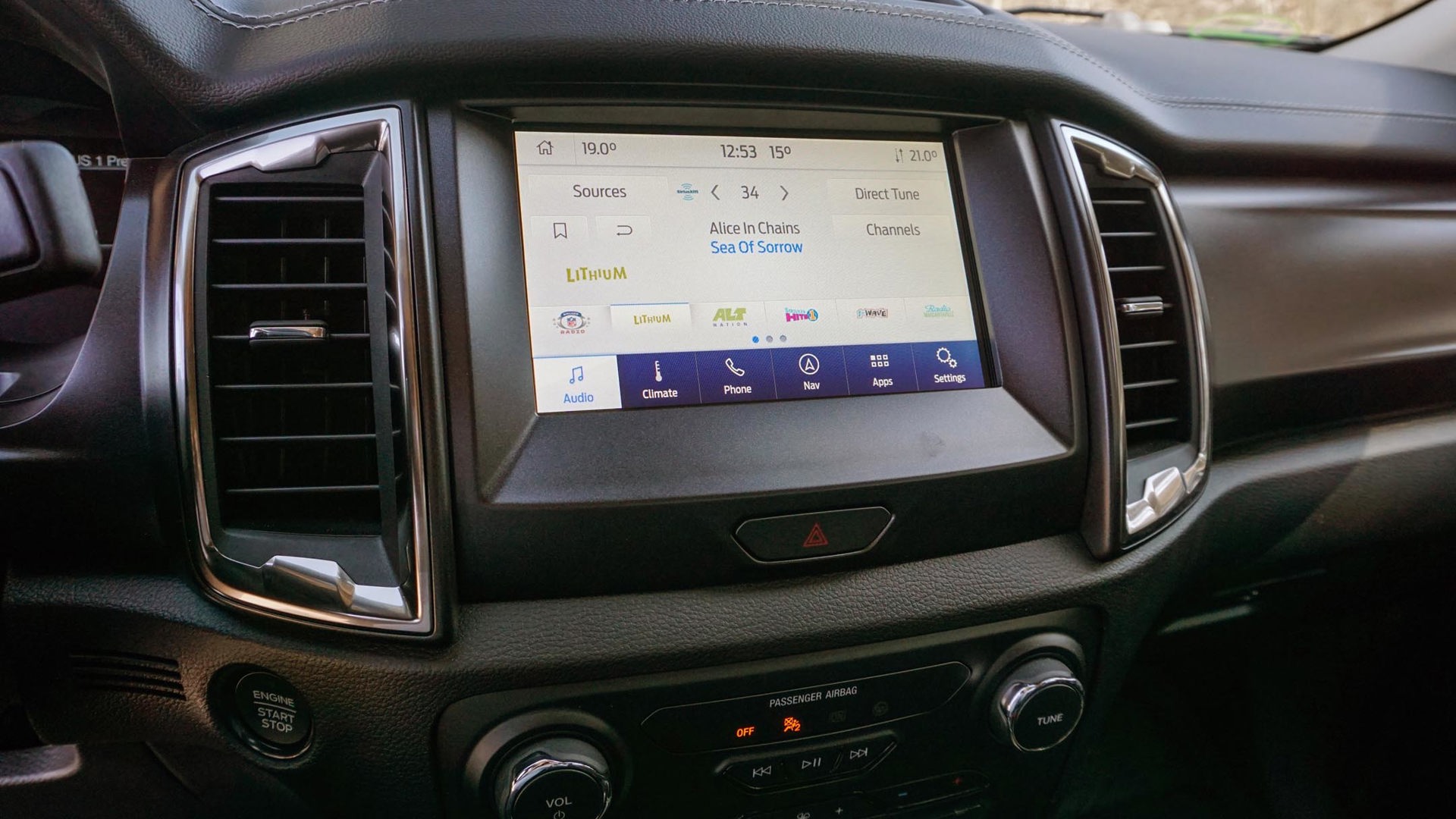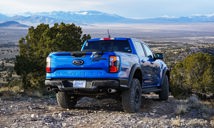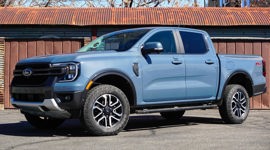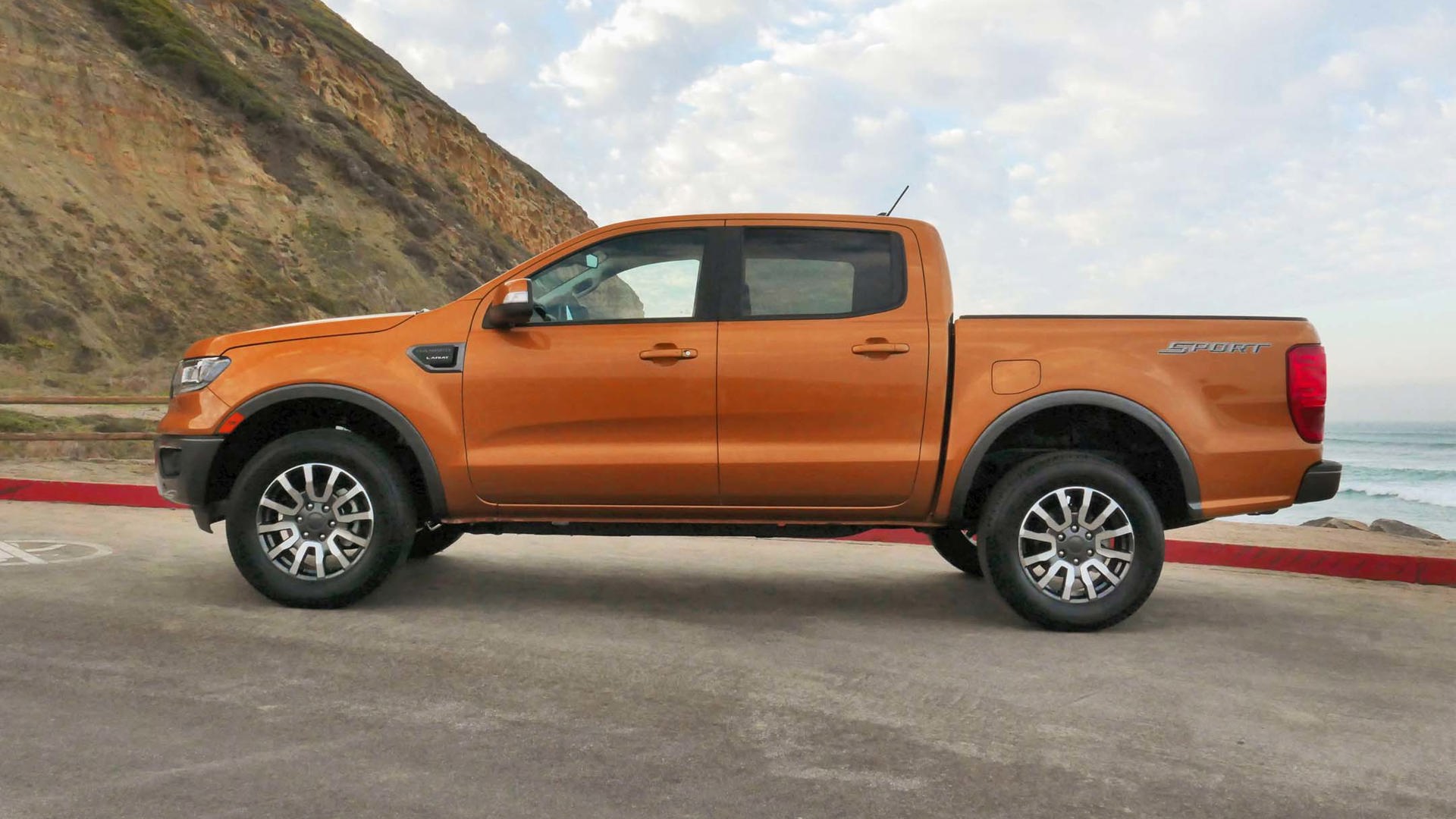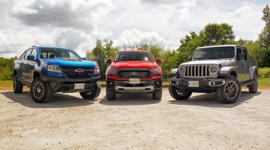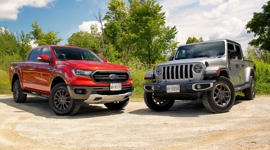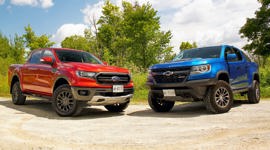 AutoTrader SCORE
AutoTrader SCORE
-
STYLING9/10
-
Safety9/10
-
PRACTICALITY8/10
-
USER-FRIENDLINESS8/10
-
FEATURES9/10
-
POWER8/10
-
COMFORT8/10
-
DRIVING FEEL7/10
-
FUEL ECONOMY9/10
-
VALUE9/10
There may be a Raptor version of Ford’s midsize pickup on its way to North America in the future, though as of this writing it’s only a few spy shots and rampant speculation to suggest that’s the case.
In the meantime, the 2021 Ford Ranger Tremor might well be a more suitable solution for more shoppers, building on the truck’s already impressive capability without pushing the performance – or the price – too far. The upgrade package also partially addresses my biggest issue with the right-sized Ranger, taking at least some of the slop out of the suspension while strengthening its off-road aptitude.
Features: 9/10
It wouldn’t quite be fair to call this truck a tweener, though it’s certainly not as hardcore a trail tackler as the Jeep Gladiator in Rubicon or Mojave guise, or the Chevrolet Colorado ZR2. Still, it’s not far off of either of those and is probably most similar to the Toyota Tacoma TRD Pro with the extras Ford has added. It also might be a better multipurpose pickup than the Ranger Raptor that may or may not be on its way, retaining all of the sensibilities of the truck it’s based on despite its boosted abilities when the pavement ends.
I hate to be the bearer of bad news, but this is no baby Raptor. It is, however, an excellent FX4 enhancement package, combining all the stuff included there – locking rear differential; terrain management system; skid plates to protect vital components – with beefier suspension bits and, maybe more crucially, proper all-terrain tires.
While the Ranger FX4 I tested displayed outstanding capability on a fairly challenging off-road course, its all-season tires were a serious shortcoming and it didn’t take long for them to get caked in mud and spin wildly as they searched for traction on the trail. However, the meaty 265-mm wide General Grabbers that come fitted to the Ranger Tremor from the factory feature an adequately aggressive tread pattern – all without generating too much noise on the street.
Value: 9/10
There’s no hiding that the $5,250 the Tremor package adds to the Ranger’s price tag is substantially more expensive than the $1,400 FX4 kit. That’s especially true considering Ford forces buyers to also spring for further upgrades that cost as much as $3,115 with the Lariat trim tested.
Even so, opting for the FX4 bundle and the $2,495 blackout package like the truck I tested last summer adds a combined $3,895 to the asking price. Now factor in the extras found here like the Fox Racing shocks with remote reservoirs in the back, the all-terrain tires, and all the exterior add-ons that enhance the Ranger’s form and function, and the Tremor package looks like a surprisingly strong value proposition.
It can only be added to the crew cab configuration, which skips the base XL trim for the choice of XLT or Lariat models. That means paying at least $46,448 with freight but before tax for the former, or $53,003 for the latter. My tester was fitted with further upgrades like a spray-in bedliner ($600), tow package ($600), and keyless entry pad ($125), pushing the pre-tax price to $54,328.
That’s not exactly cheap, but then a Tacoma TRD Pro configured the same way is priced at $58,670 before tax, while an off-road-ready GMC Canyon AT4 that’s similarly equipped rings in at $50,538 without the government’s share on top – though the latter can’t be had with much in terms of advanced safety equipment.
Safety: 9/10
That’s a problem the Ranger Tremor addresses through both standard and available systems alike, the former of which includes automatic emergency braking, lane-keep assist, automatic high-beam headlights, and blind-spot monitoring with rear cross-traffic alert. The blind-spot monitoring also provides coverage for trailers, too, assuming the dimensions are programmed into the system (three separate profiles can be saved).
While adaptive cruise control isn’t standard like it is with this truck’s rival from Toyota, it’s available as part of the XLT’s $1,000 Technology package and is included with the $3,115 upgrade that also must be added to the Ranger Lariat when opting for this Tremor version. The system works well to steadily modulate throttle and brakes on the highway, while the lane-keep assist chips in to keep the truck from wandering across painted lines.
User Friendliness: 8/10
Perhaps more importantly, though – particularly with a truck like this – is how easily all those systems and more can be disabled on the fly without the need to dive into infotainment menus. The button for the lane-keeping system is on the end of the signal stalk, while the parking sensors can be shut off via a clearly labelled button on the centre console. While disabling them does nothing to protect the sensors themselves from being damaged on the trail, it does keep them from beeping incessantly with each passing tree branch.
The console is also home to controls for the locking rear differential, tow/haul mode, traction control, and trail control (essentially off-road cruise control), as well as a rotary dial to engage four-wheel drive when it’s needed and a terrain management system button in the centre of it. While the four-wheel drive system lacks an automatic setting, both four-high and four-low settings are but a quick spin away, chipping in with extra traction when it’s needed.
It’s above all that good truck stuff that the Ranger shows its age the most, with a bank of outdated climate controls, some of which are tough to identify at a passing glance, and a laggy eight-inch touchscreen tucked into the dash for infotainment duty. Ford’s interface isn’t especially quick to respond to user inputs, with slow transitions from one function to the next, though both Android Auto and Apple CarPlay connections work much quicker. Though just like the last time I tested the Ranger, the system took to temporarily resetting itself on occasion while driving, rendering it useless for a few minutes or more each time.
Comfort: 8/10
Sadly, heated seats aren’t standard fare in the Ranger Tremor, the XLT trim requiring an expensive upgrade in order to add them. The faux-suede and leather-lined seats in my Lariat-based tester came with three-stage heat up front, though that’s where the good stuff ends. There’s no heated steering wheel, front-seat ventilation, or rear temperature control of any kind.
The front seats in particular proved comfortable and supportive throughout the course of testing, with enough bolstering to keep occupants firmly planted – even on a muddy and heavily rutted trail – while the cushions are thick enough that few adjustments are necessary on the fly. The back bench, meanwhile, is far flatter but doesn’t exactly feel like a consolation prize.
Ride quality is noticeably improved compared to the FX4, with most – though not all – of the springiness from that truck’s suspension gone here. While it’s still possible to jostle the body a bit when shifting around inside, the movement pales in comparison and feels no worse than the average pickup. The Ranger Tremor does, however, retain the FX4’s suspension rigidity that manifests on rough roads, the entire truck shuddering over broken pavement in an unpleasant way.
Power: 8/10
Under the Ranger’s hood resides but one engine choice: a turbocharged 2.3L that also serves in the base Ford Mustang. If there was any fault to be found it would be the lack of a V6 or diesel option for those who might want to tow with any frequency, with this four-cylinder’s output fairly generous at 270 hp and 310 lb-ft of torque. Those numbers have been clawed back slightly compared to the Mustang but it’s still more than enough to move this truck with some authority.
There’s a hint of turbo lag off the top and it doesn’t hit with the surge of torque typical of an engine like this, that momentum-creating force building gradually like that of a naturally aspirated V6. No, it’s the 10-speed automatic transmission that’s paired to the four-cylinder that’s the bigger problem, with plenty of quirks in its operation. When it’s time to pass, for example, it’s slow to downshift on its own, languishing instead and feeling bogged down like a manual going up a hill in too high of a gear.
The entire powertrain sounds rather coarse under moderate acceleration, too, while the transmission often struggles to decide its next move, clunking about without actually changing gears. Upon watching my video review of the Ranger FX4 in which I voiced similar complaints, one viewer opined that the 10-speed works fine and I just “need to know how to drive it.” While I can appreciate the need some folks feel to rush to the defence of their beloved vehicle, this one’s quite the stretch. All anyone needs to know about using an automatic is the difference between park, reverse, neutral, and drive, and to remember to engage tow/haul mode when moving any substantial weight.
Fuel Economy: 9/10
This drivetrain’s saving grace is its relative fuel efficiency. While the Ranger Tremor and its meaty all-terrain tires is rated at 12.2 L/100 km combined, significantly worse than the standard truck’s 10.9 L/100 km estimated average, I managed to better that number with ease. In fact, over the course of an initial evaluation drive spanning 200 km, including a short off-road excursion, I managed to burn 10.8 L/100 km. Even after the entirety of a week-long test that saw a bunch more time on the trail and a little more than 700 km added to the odometer, the final tally stood at 11.3 L/100 km.
Driving Feel: 7/10
Whether the FX4 or this enhanced Tremor version, the Ranger truly is in its element on the trail – something of a surprising characteristic. Its right-sized dimensions mean there isn’t a ton of truck to worry about when negotiating obstacles, while the drivetrain and electronic gadgetry go a long way towards getting well off the beaten path.
The additional ground clearance and wider stance this Tremor pack provides only help the Ranger get there, and this truck managed to impress me even more than before. While the two trails I tested on were different than the last time, with less rocks and other obstacles that required outright articulation and more mud to contend with, it was as surefooted as ever. In fact, the tires added to this one made all the difference, inspiring confidence to slowly crawl through the mud rather than sprint through it for fear of slipping and getting stuck.
Those tires and the stilted suspension mean it’s not the most composed when cornering quickly, with noticeable body roll on the road, though it’s just as manageable as any other midsize. The steering, while not especially crisp, is precise and well-weighted, and it’s certainly much more limber than a larger half-ton truck. It’s only the brakes that betray that spry and spritely vibe, with very little bite at the top of the pedal’s travel.
Practicality: 8/10
While sales figures would suggest I’m in the minority, I’m a firm believer that a midsize truck like this one would serve most shoppers just fine. No, it’s not as roomy inside as an F-150, but that doesn’t mean the cabin is cramped. On paper, it’s similar in size to the Ford Escape and can easily accommodate four occupants. It also benefits from some under-seat storage in the second row, though small-item storage isn’t especially abundant.
The five-foot bed bolted to the back of crew cab models like this one measure 1,550 mm (61 in) from front to back, while the 1,138 mm (44.8 in) between the wheel tubs mean it’s too narrow to carry a sheet of plywood flat in the bed, but they’ll still fit on top without issue. And I was able to fit a roughly 1,524-mm (60-in) box containing an outdoor couch in the back with the tailgate lowered and ratchet straps holding it in place. Payload is rated at 648 kg (1,429 lb) for the Tremor version, while it carries the same 3,400-kg (7,496-lb) tow rating as the rest of the Ranger lineup.
The Ranger Tremor’s revised suspension means it boasts more ground clearance than the rest of the lineup. It stands at a minimum of 247 mm (9.7 in) compared to 225 mm (8.9 in), while the shocks have been moved and the front control arms have been strengthened.
Styling: 9/10
Form meets function at the front bumper, which ditches the air dam and replaces it with a steel skid plate to go with a pair of tow hooks. It also gets painted grey finishes on the bumpers, grille, wheel arch mouldings, and wheels, as well as black tube steps, and subtle red inserts in the grille. It’s only inside that could use a bit more character, with simple “Tremor” logos embroidered on the front seats and a bank of auxiliary switches on top of the dash to set it apart from the rest of the lineup.
The Verdict
No, the 2021 Ford Ranger Tremor isn’t the Raptor wannabe some folks were surely hoping for, but it looks great and is an impressive specimen in its own right once the pavement ends – and that surely has to stand for something, right?
Those looking for a midsize truck that’s built to bash through sand dunes are better off checking out the Chevy Colorado ZR2 or holding out for the Ranger Raptor. Anyone who wants a right-sized pickup that can keep up with the likes of the Toyota Tacoma TRD Pro out on the trail should be pleased with what this Ranger Tremor has to offer. And if there’s anything this truck has going for it compared to the Raptor that’s rumoured to be on its way, it’s that this one’s available now.
| Engine Displacement | 2.3L |
|---|---|
| Engine Cylinders | Turbo I4 |
| Peak Horsepower | 270 hp @ 5,500 rpm |
| Peak Torque | 310 lb-ft @ 3,000 rpm |
| Fuel Economy | 12.3 / 12.1 / 12.2 L/100 km cty/hwy/cmb |
| Cargo Space | 1,225 L |
| Model Tested | 2021 Ford Ranger Lariat |
| Base Price | $42,688 |
| A/C Tax | $100 |
| Destination Fee | $1,950 |
| Price as Tested | $54,428 |
|
Optional Equipment
$9,690 – Tremor Off-Road Package, $5,250; 501A Equipment Group, $3,115; Trailer Tow Package, $600; Spray-in Bedliner, $600; Securicode Keyless Entry Pad, $125
|
|
